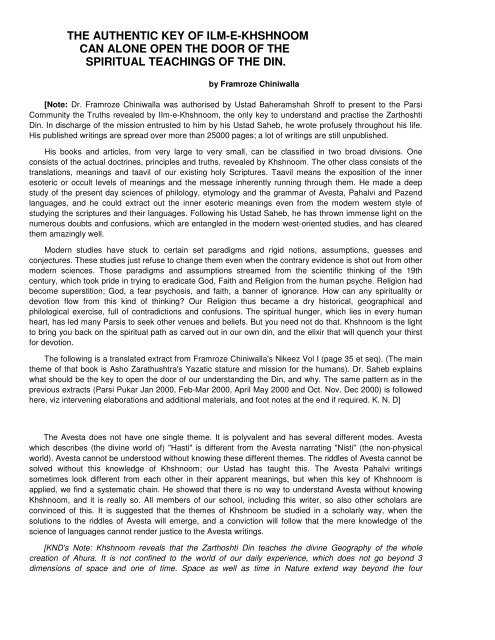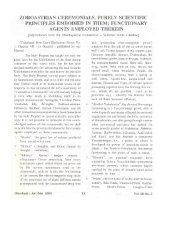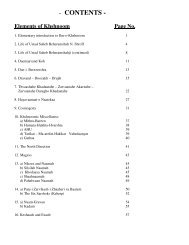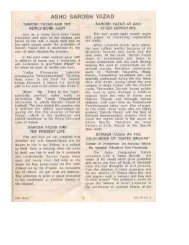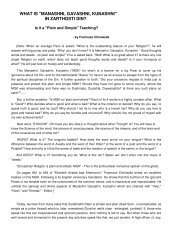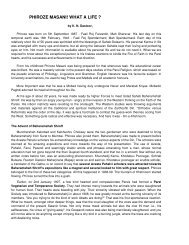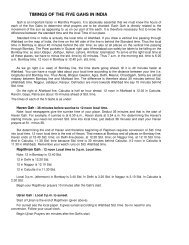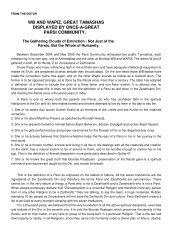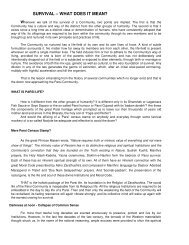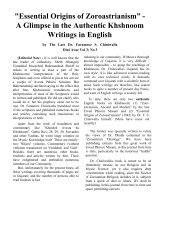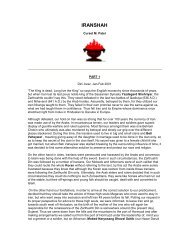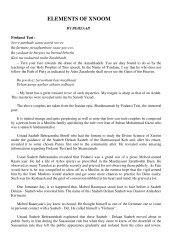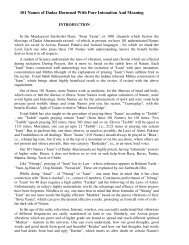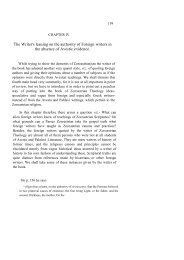the authentic key of ilm-e-khshnoom can alone open the door
the authentic key of ilm-e-khshnoom can alone open the door
the authentic key of ilm-e-khshnoom can alone open the door
Create successful ePaper yourself
Turn your PDF publications into a flip-book with our unique Google optimized e-Paper software.
THE AUTHENTIC KEY OF ILM-E-KHSHNOOM<br />
CAN ALONE OPEN THE DOOR OF THE<br />
SPIRITUAL TEACHINGS OF THE DIN.<br />
by Framroze Chiniwalla<br />
[Note: Dr. Framroze Chiniwalla was authorised by Ustad Baheramshah Shr<strong>of</strong>f to present to <strong>the</strong> Parsi<br />
Community <strong>the</strong> Truths revealed by IIm-e-Khshnoom, <strong>the</strong> only <strong>key</strong> to understand and practise <strong>the</strong> Zarthoshti<br />
Din. In discharge <strong>of</strong> <strong>the</strong> mission entrusted to him by his Ustad Saheb, he wrote pr<strong>of</strong>usely throughout his life.<br />
His published writings are spread over more than 25000 pages; a lot <strong>of</strong> writings are still unpublished.<br />
His books and articles, from very large to very small, <strong>can</strong> be classified in two broad divisions. One<br />
consists <strong>of</strong> <strong>the</strong> actual doctrines, principles and truths, revealed by Khshnoom. The o<strong>the</strong>r class consists <strong>of</strong> <strong>the</strong><br />
translations, meanings and taavil <strong>of</strong> our existing holy Scriptures. Taavil means <strong>the</strong> exposition <strong>of</strong> <strong>the</strong> inner<br />
esoteric or occult levels <strong>of</strong> meanings and <strong>the</strong> message inherently running through <strong>the</strong>m. He made a deep<br />
study <strong>of</strong> <strong>the</strong> present day sciences <strong>of</strong> philology, etymology and <strong>the</strong> grammar <strong>of</strong> Avesta, Pahalvi and Pazend<br />
languages, and he could extract out <strong>the</strong> inner esoteric meanings even from <strong>the</strong> modern western style <strong>of</strong><br />
studying <strong>the</strong> scriptures and <strong>the</strong>ir languages. Following his Ustad Saheb, he has thrown immense light on <strong>the</strong><br />
numerous doubts and confusions, which are entangled in <strong>the</strong> modern west-oriented studies, and has cleared<br />
<strong>the</strong>m amazingly well.<br />
Modern studies have stuck to certain set paradigms and rigid notions, assumptions, guesses and<br />
conjectures. These studies just refuse to change <strong>the</strong>m even when <strong>the</strong> contrary evidence is shot out from o<strong>the</strong>r<br />
modern sciences. Those paradigms and assumptions streamed from <strong>the</strong> scientific thinking <strong>of</strong> <strong>the</strong> 19th<br />
century, which took pride in trying to eradicate God, Faith and Religion from <strong>the</strong> human psyche. Religion had<br />
become superstition; God, a fear psychosis, and faith, a banner <strong>of</strong> ignorance. How <strong>can</strong> any spirituality or<br />
devotion flow from this kind <strong>of</strong> thinking? Our Religion thus became a dry historical, geographical and<br />
philological exercise, full <strong>of</strong> contradictions and confusions. The spiritual hunger, which lies in every human<br />
heart, has led many Parsis to seek o<strong>the</strong>r venues and beliefs. But you need not do that. Khshnoom is <strong>the</strong> light<br />
to bring you back on <strong>the</strong> spiritual path as carved out in our own din, and <strong>the</strong> elixir that will quench your thirst<br />
for devotion.<br />
The following is a translated extract from Framroze Chiniwalla's Nikeez Vol I (page 35 et seq). (The main<br />
<strong>the</strong>me <strong>of</strong> that book is Asho Zarathushtra's Yazatic stature and mission for <strong>the</strong> humans). Dr. Saheb explains<br />
what should be <strong>the</strong> <strong>key</strong> to <strong>open</strong> <strong>the</strong> <strong>door</strong> <strong>of</strong> our understanding <strong>the</strong> Din, and why. The same pattern as in <strong>the</strong><br />
previous extracts (Parsi Pukar Jan 2000, Feb-Mar 2000, April May 2000 and Oct. Nov. Dec 2000) is followed<br />
here, viz intervening elaborations and additional materials, and foot notes at <strong>the</strong> end if required. K. N. D]<br />
The Avesta does not have one single <strong>the</strong>me. It is polyvalent and has several different modes. Avesta<br />
which describes (<strong>the</strong> divine world <strong>of</strong>) "Hasti" is different from <strong>the</strong> Avesta narrating "Nisti" (<strong>the</strong> non-physical<br />
world). Avesta <strong>can</strong>not be understood without knowing <strong>the</strong>se different <strong>the</strong>mes. The riddles <strong>of</strong> Avesta <strong>can</strong>not be<br />
solved without this knowledge <strong>of</strong> Khshnoom; our Ustad has taught this. The Avesta Pahalvi writings<br />
sometimes look different from each o<strong>the</strong>r in <strong>the</strong>ir apparent meanings, but when this <strong>key</strong> <strong>of</strong> Khshnoom is<br />
applied, we find a systematic chain. He showed that <strong>the</strong>re is no way to understand Avesta without knowing<br />
Khshnoom, and it is really so. All members <strong>of</strong> our school, including this writer, so also o<strong>the</strong>r scholars are<br />
convinced <strong>of</strong> this. It is suggested that <strong>the</strong> <strong>the</strong>mes <strong>of</strong> Khshnoom be studied in a scholarly way, when <strong>the</strong><br />
solutions to <strong>the</strong> riddles <strong>of</strong> Avesta will emerge, and a conviction will follow that <strong>the</strong> mere knowledge <strong>of</strong> <strong>the</strong><br />
science <strong>of</strong> languages <strong>can</strong>not render justice to <strong>the</strong> Avesta writings.<br />
[KND's Note: Khshnoom reveals that <strong>the</strong> Zarthoshti Din teaches <strong>the</strong> divine Geography <strong>of</strong> <strong>the</strong> whole<br />
creation <strong>of</strong> Ahura. It is not confined to <strong>the</strong> world <strong>of</strong> our daily experience, which does not go beyond 3<br />
dimensions <strong>of</strong> space and one <strong>of</strong> time. Space as well as time in Nature extend way beyond <strong>the</strong> four
dimensional space time continuum Einstein could gauge. In <strong>the</strong> realm <strong>of</strong> pure ma<strong>the</strong>matics <strong>the</strong> concepts. <strong>of</strong><br />
4th dimension and n dimensions was prevalent even in <strong>the</strong> 19th century. 1 Sir James Jeans an eminent<br />
astrophysicist had said that <strong>the</strong> universe we observe arises out <strong>of</strong> a suppression <strong>of</strong> dimensions <strong>of</strong> space into<br />
3 dimensions <strong>of</strong> our experience viz length, breadth and height. 2 Beyond <strong>the</strong> physical universe <strong>of</strong> our<br />
observation, <strong>the</strong>re are broadly two fur<strong>the</strong>r worlds - Nisti and Hasti. Nisti is <strong>the</strong> non-physical world; it is not<br />
constituted <strong>of</strong> matter; its basic component is "non-physical energies", which are very subtle going beyond our<br />
material world. A general name for such energies is "Anaasar". They entangle amongst <strong>the</strong>mselves in various<br />
frequencies and intensities which at one stage gives rise to elementary particles like electron, proton, neutron<br />
and a host <strong>of</strong> o<strong>the</strong>rs. These <strong>the</strong>n combine to form atoms, <strong>the</strong> basic foundation <strong>of</strong> visible matter. 3<br />
The Nisti, <strong>the</strong> world <strong>of</strong> non-physical energies have seven "Dakhyoo"s, named in Meher Niyaish as Aivee<br />
Dakhyoo, Antarey Dakhyoo, Aa Dakhyoo, Upairee, Adairee, Pairee, Aipee-'Dakhyoo's. ("Mithrem Airi<br />
Dakhyam Yazmaide, Mithrem Antare Dakhyam Yazmaide….") In <strong>the</strong> western oriented studies, <strong>the</strong>se are<br />
translated as "We praise mithra, who is around (Aivi) <strong>the</strong> country (region), within (Antarey) <strong>the</strong> country in (Aa),<br />
above (Upairi), under (Adairi), before (Pairi), and behind (Aipi) <strong>the</strong> country. "Dakhyoo" is translated as country<br />
or region and "Yazmaide" as "Praise we" or more pompous "we sacrifice" (Dhalla-"Nyaishes" 1 :71). These<br />
Aivi, Antarey, Aa, Upairi, Adairi, Pairi, Aipi are however <strong>the</strong> names <strong>of</strong> certain stations or regions or places in<br />
<strong>the</strong> Nisti world, which has <strong>the</strong> technical name: Dakhyoo. Without <strong>the</strong> knowledge <strong>of</strong> this truth, <strong>the</strong> passage<br />
reads primitive or at least not worth reciting as a prayer every morning! Hundreds <strong>of</strong> examples <strong>can</strong> be given<br />
where such "sublime to ridicule" translations have labeled our Religious scriptures as "Childish", (as Pr<strong>of</strong><br />
Brown actually told Dr. lrach Taraporewala 4 . So, Framroze Chiniwalla points out that Avesta has different<br />
<strong>the</strong>mes and <strong>the</strong>refore different meanings <strong>of</strong> <strong>the</strong> same word at different places. The word Dakhyoo in Ujiran<br />
Gah has a different chapter <strong>of</strong> truth to declare and Dakhyoo in Gatha Haa 48-12 has a different one.<br />
Similarly, 'Hasti' is <strong>the</strong> divine Continent <strong>of</strong> Ahura's Creation. It is constituted <strong>of</strong> Ahura's own Light,<br />
emanating as <strong>the</strong> Yazatic Rays. The divine stations in Hasti are called 'Aasmaan's (like 'Dakhyoo's in Nisti).<br />
And <strong>the</strong> Avesta referring to Hasti has a <strong>the</strong>me different from <strong>the</strong> <strong>the</strong>me <strong>of</strong> Nisti. Khshnoom is thus <strong>the</strong> science<br />
<strong>of</strong> Zarthoshti Din, which has a special language and special technical terms. They are to be understood<br />
through a special technique. The technique <strong>of</strong> <strong>the</strong> modern way <strong>of</strong> studying <strong>the</strong> Din is wrong and has led<br />
astray all <strong>the</strong> scholars and laymen. Dr. Saheb continues:]<br />
Philology says that <strong>the</strong> languages have in <strong>the</strong>m <strong>the</strong> history, geography etc <strong>of</strong> <strong>the</strong> past times; that <strong>can</strong> be<br />
taken as correct in a way. But <strong>the</strong> real spirit - <strong>the</strong> inner mystery, which <strong>the</strong> meanings <strong>of</strong> a word in a sacred<br />
language has, is like <strong>the</strong> soul and life-force in <strong>the</strong> physical body <strong>of</strong> <strong>the</strong> word. When <strong>the</strong> soul gets out <strong>of</strong> a body<br />
and <strong>the</strong> life-force is switched <strong>of</strong>f, <strong>the</strong> life-less body looses its quality to attract o<strong>the</strong>rs towards it; nobody is<br />
attracted to it, because it has lost its power <strong>of</strong> expression. Similarly <strong>the</strong> ordinary outward meanings <strong>of</strong> those<br />
words have no expression which <strong>can</strong> really attract.<br />
Therefore <strong>the</strong> inner (esoteric, secret, mystical) meaning is like <strong>the</strong> soul and life-force <strong>of</strong> <strong>the</strong> word. That<br />
<strong>alone</strong> <strong>can</strong> reveal <strong>the</strong> real expression, and because <strong>of</strong> <strong>the</strong> real attraction <strong>of</strong> divine knowledge, every one <strong>can</strong><br />
get <strong>the</strong> real bliss, happiness and ecstasy, according to his own individual capacity to absorb. When you get<br />
Khshnoom, it must contain <strong>the</strong> spiritual bliss, so that <strong>the</strong> ecstasy <strong>of</strong> devotion <strong>can</strong> spread to every atom <strong>of</strong> your<br />
body and <strong>the</strong> sublime thoughts <strong>of</strong> Frasho-Kereyti <strong>can</strong> condense in your mind. In a human body, in addition to<br />
<strong>the</strong> life force (Jaan) and soul (Ruvaan), <strong>the</strong>re are Baod and Fravashi. In <strong>the</strong> same way a sacred word has<br />
deep in it, Boad and Fravashi, <strong>the</strong> components, which even go beyond life force and soul. There are thus<br />
several inner and innermost levels to <strong>the</strong> meaning <strong>of</strong> a sacred word. So, through Ilm-e-Khshnoom, we <strong>can</strong><br />
understand Avesta, <strong>the</strong> words <strong>of</strong> Avesta, and its style and diction (<strong>the</strong> flow <strong>of</strong> words and sentences). They are<br />
a "taleysam", that is, <strong>the</strong>y have inherent spiritual power and <strong>can</strong> talk with us, and convey its inner energy to<br />
us. Their secret meanings are like Jaan, Ruvaan, Baod and Farohar, and <strong>can</strong> provide a wealth <strong>of</strong> information<br />
and spiritual knowledge.<br />
[KND's Note: Dr. Saheb emphasizes that every Avesta word is a power house <strong>of</strong> spiritual energy. It is like<br />
a living human personality with Jaan, Ruvaan, Baod, Fravashi. It has levels and levels <strong>of</strong> inner secret<br />
meanings. The meanings given by <strong>the</strong> western philology are outwardly etymological, dry, spiritless, life-less.<br />
They treat Avesta as ordinary writings and literature. When Ustad Saheb Baheramshahji revealed <strong>the</strong> inner
spiritual essence <strong>of</strong> several Avesta words before <strong>the</strong> western oriented Parsi scholars, many <strong>of</strong> <strong>the</strong>m were<br />
stunned. Khurshedji Kama, <strong>the</strong> pioneer <strong>of</strong> <strong>the</strong> western studies in India, was so much electrified that he<br />
adopted Baheramshahji's meanings in his own studies. This is recorded by ano<strong>the</strong>r erudite scholar<br />
Khodabax Poonegar vide Baheramshah Shr<strong>of</strong>f Frashogard Memorial Volume- page 151. In a public speech,<br />
Khureshedji Kama declared that we <strong>the</strong> scholars have done nothing except dryly translating Avesta<br />
writings; we do not know <strong>the</strong> inner secret meanings <strong>of</strong> Avesta; it is necessary that <strong>the</strong>se must be<br />
<strong>open</strong>ed out and revealed. This is recorded by Manchershah Kekobad, <strong>the</strong> first disciple <strong>of</strong> Baheramshahji in<br />
<strong>the</strong> above Memorial Volume (p.253).<br />
The holy scriptures <strong>of</strong> any Religion are not literature. They are called 'Mantra' in Sanskrit and Manthra in<br />
Avesta. They are <strong>the</strong> divine vibrations <strong>of</strong> Nature, expressed in words which <strong>can</strong> be pronounced by <strong>the</strong> human<br />
tongue. Every word is <strong>the</strong>refore God's word in human speech. It contains <strong>the</strong> inner most secrets whirling in<br />
Ahura's creation. It has <strong>the</strong>refore a powerful spiritual effect within <strong>the</strong> person pronouncing it, as also outside<br />
him, in <strong>the</strong> "outer" world. This applies to all <strong>the</strong> holy books <strong>of</strong> all Religions. Aurobindo Ghosh has, in <strong>the</strong><br />
"Introduction" to his "Hymns to <strong>the</strong> Mystical Fire" said that <strong>the</strong> western scholars have no capacity to grasp<br />
<strong>the</strong> inner meanings <strong>of</strong> <strong>the</strong> Vedic 'Mantra' formulated by <strong>the</strong> ancient Rishis. Sufi saints and Imams have<br />
declared that <strong>the</strong> holy Koran has hidden levels <strong>of</strong> meanings 5 . So also, <strong>the</strong> Jews assign secret meanings to <strong>the</strong><br />
Hebrew Bible. 6<br />
Avesta is <strong>the</strong>refore a treatise on <strong>the</strong> spiritual secrets <strong>of</strong> Nature, and requires a <strong>key</strong> to <strong>open</strong> <strong>the</strong> secret<br />
code. Ilm-e-Khshnoom is <strong>the</strong> only au<strong>the</strong>ntic <strong>key</strong>. The meanings assigned by Khshnoom leads you to <strong>the</strong><br />
Inner science <strong>of</strong> Ahura. It is not like present day empirical sciences, which merely rely on physical observation<br />
and try to understand nature’s laws through inferences, logical and ma<strong>the</strong>matical. This is a quest <strong>of</strong> truth from<br />
<strong>the</strong> bottom. Mystical sciences are <strong>the</strong> o<strong>the</strong>r way round. They are not <strong>the</strong> quest <strong>of</strong> truth by mortal humans;<br />
<strong>the</strong>y are <strong>the</strong> reports on Truth revealed by <strong>the</strong> Prophets, Avataars, Saints and men and women <strong>of</strong> God.<br />
These Reports are in <strong>the</strong> language <strong>of</strong> 'Manthra'; Mystical sciences like 'Kabalah' <strong>of</strong> Judaism, 'Sufism' <strong>of</strong> Islam,<br />
'Brahma -Vidya' <strong>of</strong> Hinduism, IIm-e-Khshnoom <strong>of</strong> Zarthosti Din, Gnosticism <strong>of</strong> <strong>the</strong> Christians reveal <strong>the</strong> Truths<br />
as sealed in <strong>the</strong> holy Scriptures. If you <strong>the</strong>refore desire to know <strong>the</strong> Truths embedded in Avesta, study IIm-e-<br />
Khshnoom. There is no o<strong>the</strong>r way. Dr. Saheb asserts that this study <strong>of</strong> Khshnoom shall spiritually elevate you,<br />
shall enwrap you in bliss and ecstasy, and shall take you "Nearer to Thee, my Lord". Alas! For <strong>the</strong> so called<br />
scholar Dastoors!<br />
FOOT NOTES:<br />
1. The Fourth Dimension and How to get <strong>the</strong>re by Rudi Rucker (Penguin 1985) is an excellent book explaining <strong>the</strong> ideas<br />
and <strong>the</strong>ories about <strong>the</strong> dimensions beyond our ordinary consciousness.<br />
2. "The Mysterious Universe".<br />
3. The composition <strong>of</strong> Anaasar, Matter and Cell are explained in Framroze Chiniwalla's "Aapni Aa Geyti". The still deeper<br />
treatment is in Nikeez vol. II p. 319) (Also Vendidaad p.241).<br />
4. Divine songs <strong>of</strong> Zarathushtra -('Gatha's) Introduction -page XVI- 1951. )1993 Edition by "Hukhta Foundation").<br />
5. "Mystical Dimensions <strong>of</strong> Islam by Annemarie Schimmel (page 41) (Chappel Hill 1975). Also "The Mystics <strong>of</strong> Islam" by<br />
Reynold A Nicholson -p.23 (Arkana -1989)<br />
6. "Path <strong>of</strong> <strong>the</strong> Kabalah" by David Sheinkin (Chapter two: 'The Mystical Bible). (Paragon House 1986).<br />
"SEER WISDOM" AND "SECRET WORDS"<br />
Aurobindo Ghosh writes, "The Vedic Rishis believed that <strong>the</strong>ir 'Mantra's were inspired from higher<br />
hidden planes <strong>of</strong> consciousness and contained this secret knowledge. The words <strong>of</strong> <strong>the</strong> Veda could only<br />
be known in <strong>the</strong>ir true meaning by one who was himself a seer or mystic; from o<strong>the</strong>rs <strong>the</strong> verses
withheld <strong>the</strong>ir hidden knowledge. The Rishi Dirghatamas speaks <strong>of</strong> <strong>the</strong> Riks, <strong>the</strong> 'Mantra's <strong>of</strong> <strong>the</strong> Veda,<br />
as existing "in a supreme e<strong>the</strong>r imperishable and immutable in which all <strong>the</strong> gods are seated"... The<br />
word and <strong>the</strong> thought <strong>of</strong> <strong>the</strong> Veda belongs to <strong>the</strong> higher planes... ...Those who do not know <strong>the</strong> inner<br />
sense are as men who seeing see not, hearing hear not... (Those) unable to drink steadily <strong>the</strong> milk <strong>of</strong> <strong>the</strong><br />
Word, <strong>the</strong> Vedic cow, move with it as with one that gives no milk, to him <strong>the</strong> Word is a tree without<br />
flowers or fruits... There (is) an occult and spiritual knowledge in <strong>the</strong> sacred hymns and by this<br />
knowledge <strong>alone</strong>... ...one <strong>can</strong> know <strong>the</strong> truth and rise to a higher existence."<br />
"O<strong>the</strong>rwise, <strong>the</strong> Veda must remain for ever a sealed book; grammarians, etymologists, scholastic<br />
conjectures will not <strong>open</strong> to us <strong>the</strong> sealed chamber." Aurobindo in "Hymns to <strong>the</strong> Mystic Fire" - pages 5,<br />
6)<br />
(Substitute 'Avesta' for Veda and you will understand.)<br />
(Parsi Pukar Apr.-May.-June 2001 - Vol. 6; No. 4)
AVESTA IS MANTHRIC COMPOSITION BASED ON<br />
THE DIVINE SCIENCE OF STAOTA YASNA.<br />
IT IS NOT TO BE TREATED AS AN ORDINARY SPOKEN<br />
LANGUAGE - THE WORDS HAVE SPECIAL TECHNICAL AND<br />
MYSTICAL MEANINGS.<br />
By DR. Saheb Framroze Chiniwalla<br />
[Note: In <strong>the</strong> last issue, Dr. Framroze Chiniwalla made out <strong>the</strong> following points:<br />
1. The <strong>the</strong>me <strong>of</strong> Avesta is polyvalent. For instance, Avesta describing or referring to Hasti - <strong>the</strong> Yazatic<br />
divine World - is different from that <strong>of</strong> Nisti - <strong>the</strong> non-physical energy world. Even <strong>the</strong> grammar and syntax<br />
vary accordingly.<br />
2. The <strong>key</strong> to decipher this riddle is "Staota Yasna", <strong>the</strong> mystical Science <strong>of</strong> Vibrations. Without that <strong>key</strong>,<br />
Avesta <strong>of</strong>ten seems to be contradictory at different places. But it is not, in truth, so.<br />
3. IIm-e-Khshnoom has <strong>the</strong> knowledge, which <strong>can</strong> apply <strong>the</strong> <strong>key</strong> and show <strong>the</strong> grand consistency <strong>of</strong><br />
Avesta, Gathic or non-Gathic or earlier and 'later', as erroneously branded in <strong>the</strong> Western studies.<br />
4. Avesta is <strong>the</strong> language <strong>of</strong> Manthra, not <strong>of</strong> literature. Every word has deeper levels <strong>of</strong> meaning and<br />
message - not one only, but many. Without <strong>the</strong> application <strong>of</strong> <strong>the</strong> decoding <strong>key</strong>, <strong>the</strong> Avesta word is like a<br />
corpse without any life or soul in it.<br />
5. The translations rendered by Khshnoom, take care <strong>of</strong> <strong>the</strong> hidden mystical meanings and in so<br />
doing, emphasize how <strong>the</strong> present-day grammar, philology and etymology <strong>the</strong>mselves <strong>can</strong> be <strong>of</strong> help.<br />
6. lt is <strong>the</strong> sacred and secret meaning <strong>of</strong> Avesta words that <strong>can</strong> inspire devotion and bliss in <strong>the</strong><br />
praying heart. It has <strong>the</strong> divine power to communicate and be communicated, with <strong>the</strong> Yazatic<br />
Energies and Forces whirling in Nature.<br />
Dr. Saheb now elaborates fur<strong>the</strong>r:]<br />
A person may be highly erudite in <strong>the</strong> English language, but that does not mean that he understands duly<br />
and properly a book relating to a technical branch <strong>of</strong> knowledge. If he does not have any true knowledge, say,<br />
<strong>of</strong> <strong>the</strong> <strong>the</strong>me <strong>of</strong> medical science, and has not learnt different words conveying different meanings in different<br />
branches <strong>of</strong> that science and its scheme, he will not understand <strong>the</strong> true meaning and purport <strong>of</strong> <strong>the</strong> words,<br />
notwithstanding his pr<strong>of</strong>ound knowledge <strong>of</strong> <strong>the</strong> English language. He will not be able to do justice to <strong>the</strong><br />
technical <strong>the</strong>me. If he has not known <strong>the</strong> <strong>the</strong>me <strong>of</strong> <strong>the</strong> medical, surgical, obstetrical and o<strong>the</strong>r technical<br />
matters <strong>of</strong> that science and has not studied, say, anatomy, <strong>the</strong> science <strong>of</strong> <strong>the</strong> structure <strong>of</strong> <strong>the</strong> physical body<br />
and o<strong>the</strong>r allied subjects and <strong>the</strong>ir <strong>the</strong>me, <strong>the</strong> Mithra i.e. <strong>the</strong> thought behind; <strong>the</strong> Manthra i.e. <strong>the</strong> study and<br />
grasp <strong>of</strong> <strong>the</strong> <strong>the</strong>me by <strong>the</strong> words conveying it, and <strong>the</strong> Yasna i.e. <strong>the</strong> practical application <strong>of</strong> it, <strong>the</strong>n he will<br />
not be able to render any justice to <strong>the</strong> writings <strong>of</strong> that science howsoever learned grammarian <strong>of</strong> <strong>the</strong> English<br />
he may be. In <strong>the</strong> same way, we <strong>of</strong> <strong>the</strong> Western School <strong>of</strong> Medicine, are doing injustice to <strong>the</strong> old Aurvedic<br />
and o<strong>the</strong>r schools <strong>of</strong> medicine. The books written by <strong>the</strong> experts <strong>of</strong> such old schools have quite different<br />
<strong>the</strong>mes and so <strong>the</strong>ir writings hardly get justice. It is <strong>the</strong>refore clear and obvious that we must know <strong>the</strong> <strong>the</strong>me<br />
<strong>of</strong> each branch <strong>of</strong> knowledge and learning. The medical man <strong>of</strong> today knows <strong>the</strong> <strong>the</strong>me <strong>of</strong> modern medicinal<br />
sciences; he will <strong>the</strong>refore positively believe in it and will never raise any question about it. If he raises such a<br />
question, he will be taken as quack, non-medical or even out <strong>of</strong> mind. For example, a book treating <strong>the</strong><br />
anatomy <strong>of</strong> a male will not refer at all to female organs. If somebody says that <strong>the</strong> book is incomplete because<br />
it does not describe even one female organ, he will be declared a quack or out <strong>of</strong> mind. Quack means one<br />
who is ignorant <strong>of</strong> <strong>the</strong> established medical thought and <strong>the</strong>refore unau<strong>the</strong>ntic and unreliable and so<br />
unjustified. How <strong>can</strong> medical book at all contain engineering matters? And how <strong>can</strong> an engineering book at all
contain legal matters? In <strong>the</strong> same way, <strong>the</strong> whole <strong>of</strong> cosmogenesis taught in <strong>the</strong> Din, has its innumerable<br />
Mithra, Manthra, Yasna, all <strong>of</strong> which is in <strong>the</strong> consciousness and conscience <strong>of</strong> <strong>the</strong> Creator <strong>of</strong> all <strong>the</strong> worlds,<br />
which is called Mazdayasni Zarthoshti Din; all that <strong>can</strong>not be in one single Book. Different Books are<br />
required for each subject matter. That means we must have knowledge <strong>of</strong> Mithra, Manthra, Yasna. Many<br />
many encyclopedias (Farhang) are formulated on <strong>the</strong> basis <strong>of</strong> such Mithra. Each <strong>of</strong> those encyclopedias has<br />
in it <strong>the</strong> corresponding Mithra and <strong>the</strong>reon is based <strong>the</strong> Theme <strong>of</strong> Avesta. Therefore <strong>the</strong> statement that all is<br />
in <strong>the</strong> Gatha only, and all Avesta o<strong>the</strong>r than Gatha is not <strong>of</strong> Zarathushtra is full <strong>of</strong> ignorance.<br />
[KND's Note: The meaning <strong>of</strong> <strong>the</strong> same word occurring in different branches <strong>of</strong> knowledge may be entirely<br />
different. Mere etymology may mislead. Take for instance <strong>the</strong> words "Aqua Regia", and apply a dose <strong>of</strong><br />
etymology. 'Aqua' rooted from Latin means water; 'regia' means royal. So it means 'Royal Water'. A very<br />
learned etymologist may conjecture (as is <strong>the</strong> habit <strong>of</strong> all etymologists) that it must be some liquid which <strong>the</strong><br />
kings used to drink, a royal drink. (There is a 'Royal Salute', a brand <strong>of</strong> Whisky). It is clear that <strong>the</strong> honourable<br />
etymologist is entirely ignorant <strong>of</strong> <strong>the</strong> branch <strong>of</strong> science called Chemistry. Aqua Regia <strong>the</strong>re means mixture <strong>of</strong><br />
three parts hydrochloric acid and one part nitric acid, both highly concentrated. It is named as Royal Water<br />
not because <strong>the</strong> kings royal used to drink it; but that it is so much strongly acidic and corrosive that even<br />
<strong>the</strong> royal and noble metal, gold, dissolves away in it! It is not <strong>the</strong> pleasure <strong>of</strong> human royalty; it is <strong>the</strong><br />
dissolution <strong>of</strong> <strong>the</strong> metallic royalty. It does not take <strong>the</strong> kingly drinker to <strong>the</strong> usual alcoholic bliss but to a<br />
horrible stomach burning death! The poor etymologist will be taken aback at <strong>the</strong> true meaning and fur<strong>the</strong>r<br />
stunned if he is told that aqua regia, although dissolves gold, does not dissolve silver, <strong>the</strong> less royal metal!<br />
But he will compose himself and say in royal tone, "Oh! Is it? NOW I understand why royal kings preferred<br />
silver crowns and why <strong>the</strong> royal queen Brakidabri <strong>of</strong> Kampastan was dissolved because she insisted on<br />
wearing <strong>the</strong> golden crown……………."<br />
In <strong>the</strong> study <strong>of</strong> our holy Scriptures, we come across several such exercises germinating from <strong>the</strong> Western<br />
and West Oriented Scholasticism. Please do not misunderstand. I have great respect for <strong>the</strong> Western<br />
Scholars, My teacher Bapaji (Rustom Dastoor Meherjirana) spoke highly <strong>of</strong> <strong>the</strong>ir strenuous exertions<br />
and arduous labour in trying to understand our sacred Books. But <strong>the</strong>y had and have <strong>the</strong>ir limitations<br />
emanating from <strong>the</strong> Western scientific and so called "progressive" thinking <strong>of</strong> <strong>the</strong> 19th century. They<br />
formulated <strong>the</strong>ir own paradigms and are carried away by <strong>the</strong>m. The two most prominent stickers are: (i) that<br />
<strong>the</strong> only 'Zoroastrian' content is in <strong>the</strong> Gatha. Non-Gathic Avesta and Pazend, and <strong>the</strong> Pahalvi writings are<br />
"non-Zoroastrian", designed by later Zoroastrian priests; and (ii) that our ancestral Iranis had <strong>the</strong> custom <strong>of</strong><br />
marriage between bro<strong>the</strong>r and sister, mo<strong>the</strong>r and son and fa<strong>the</strong>r and daughter, termed as "Khaetvodath" and<br />
that is considered as <strong>the</strong> highest 'spiritual' goal <strong>of</strong> our Din!<br />
Such misnomers are <strong>the</strong> basis <strong>of</strong> <strong>the</strong>ir study which results in several exercises <strong>of</strong> <strong>the</strong> Aqua Regia types. I<br />
present one example.<br />
In Gatha Ha 49-1, Asho Zarathushtra is stated to be lamenting,<br />
"I want to please through Asha, those who have gone astray on "<strong>the</strong> path <strong>of</strong> evil, but Oh Mazda! That<br />
strongest Bendva constantly resists against me. Come to me with Thy good gifts. I am searching for his<br />
death through Vohu mano - good mind."<br />
The scholarly question arose who was this 'Bendva' named in <strong>the</strong> stanza. Mills said, it was a border chief,<br />
a strong enemy <strong>of</strong> Zoroaster, obstructing His mission and harassing Him. Haug said it was "Paandoo" (fa<strong>the</strong>r<br />
<strong>of</strong> five Pandava's?). Justi said it was "Bhindoo". This is that aqua regia exercise. Pahalvi writings use <strong>the</strong><br />
word "Badtum Demaano" which indicates <strong>the</strong> Daeva <strong>of</strong> <strong>the</strong> most evil times". The earth passes through<br />
time cycles <strong>of</strong> good and evil. In evil times, <strong>the</strong> ways <strong>of</strong> Din are forgotten and abandoned. Such time is<br />
presided by a mighty Daeva <strong>of</strong> evil whose technical name is Bendva. The stanza asks: when will such<br />
times be ended? When will Bendva be dissolved and evil times vanished for ever? Look at <strong>the</strong> way in which<br />
<strong>the</strong>se studies have failed to grasp <strong>the</strong> real essence <strong>of</strong> <strong>the</strong> Truth declared in <strong>the</strong> stanza. Bedva is nei<strong>the</strong>r<br />
Pandoo nor Bhindoo (or Eethoo), whose death Zoroaster wishes "with His good mind". When I first read <strong>the</strong><br />
Western translation, I wondered, how <strong>can</strong> death <strong>of</strong> anybody <strong>can</strong> be wished through "good mind" and that too<br />
<strong>the</strong> mind <strong>of</strong> a holy Prophet?
How <strong>can</strong> a holy man <strong>of</strong> God pass sleepless nights worrying about a border chief? And was Pandoo a<br />
Hindu enemy <strong>of</strong> Parsi Zoroaster and <strong>the</strong> latter wished like a Parsi Lady. "Tu mare, mari geyo"? (We live in<br />
Bharata <strong>of</strong> <strong>the</strong> Hindus!). And why should we recite Gatha as prayer when it narrates some such political<br />
conflicts? What kind <strong>of</strong> 'prayer' is this? And what 'gifts' Zoroaster asks for from Mazda to kill <strong>the</strong> border<br />
enemy? Atomic and/or biological weapons?<br />
…….. It is only <strong>the</strong> Khshnoomic translation which reveals <strong>the</strong> technical meaning <strong>of</strong> Bendva viz. <strong>the</strong> evil<br />
daeva <strong>of</strong> <strong>the</strong> evil cycle <strong>of</strong> time, and also his complete disappearance from <strong>the</strong> earth which will result in<br />
Frashogard and no more evil-time cycles. The Pahalvi translation <strong>of</strong>, and <strong>the</strong> commentaries on 49-1 reveal<br />
this truth and Khshnoom elaborates it. I assure my readers <strong>the</strong>re are scores <strong>of</strong> this aqua regia and Pandoo -<br />
Bhindoo types.<br />
Dr. Saheb points out that such wild guessworks and conjectures arise from <strong>the</strong> unawareness <strong>of</strong> <strong>the</strong> main<br />
Themes <strong>of</strong> Avesta. He emphasies that <strong>the</strong> Avesta passages, sentences and words are to be understood on<br />
<strong>the</strong> foundation <strong>of</strong> <strong>the</strong> Knowledge about <strong>the</strong> Themes <strong>of</strong> Truths contained in <strong>the</strong>m. That <strong>alone</strong> <strong>can</strong> reveal <strong>the</strong><br />
technical and mystical meanings and solve <strong>the</strong> riddles flowing from <strong>the</strong> apparent so-called flaws in grammar,<br />
which brands Avesta as corrupt at several places. It is not 'corruption'; it is our ignorance. Try to understand<br />
<strong>the</strong> <strong>the</strong>me and remove <strong>the</strong> perplexities. You <strong>can</strong> do this through Khshnoom. Try to study Khshnoom<br />
sincerely and objectively. Remove your lure for western scholars. They are immune to mystical<br />
sciences and <strong>the</strong>y <strong>can</strong>not be blamed for that. Their thinking and upbringing is spiritually immature.<br />
They are <strong>the</strong>refore in <strong>the</strong> sea <strong>of</strong> uncertainties with <strong>the</strong>ir scores <strong>of</strong> entirely variant and <strong>of</strong>ten inconsistent<br />
translations. We <strong>can</strong>not rely on <strong>the</strong>ir university exercises and degrees. For us it is a question <strong>of</strong> our<br />
Faith and our survival.<br />
And Mind! The translations <strong>of</strong> all Avesta, Gathic and non-Gathic, by Dr. Framroze Chiniwalla have<br />
amazing consistency, congruence, concordance and harmony. I have seen him working; I have learnt from<br />
him. It is no exaggeration but a bare truth that <strong>the</strong> amount <strong>of</strong> work and exertion he has put in, in his marathon<br />
writings spread over several standard and scholarly volumes and articles in Frashogard and PARSI AVAZ, is<br />
much more than <strong>the</strong> works <strong>of</strong> any o<strong>the</strong>r savant and writer on our Din, Western or Eastern. Just have a look at<br />
his Gatha-Spentomad, a work <strong>of</strong> 482 pages with an index <strong>of</strong> 16 pages. Each stanza <strong>of</strong> each <strong>of</strong> <strong>the</strong> Ha's 47 to<br />
50 has (i) an introductory note, (ii) a short summary, (iii) Avesta text, (iv) word to word translation, (v) Pahalvi<br />
translation and explanation, (vi) meanings and roots <strong>of</strong> words, (vii) commentary and Taavil, (viii) how <strong>the</strong><br />
content <strong>of</strong> <strong>the</strong> passage is given in three different interpretations in <strong>the</strong> Pahalvi Nasks : Sudkar,<br />
Varashtamaansra and Baga, in <strong>the</strong> Dinkard, volume 9, chapters 21, 44 and 46; Sanjanas' volumes 17 (pages<br />
46-48), Vol. 18 (p. 39-42), Vol. 19 (p. 52-53); and (ix) <strong>the</strong> Pahalvi text <strong>of</strong> <strong>the</strong> said three Nasks in Dinkard and<br />
<strong>the</strong>ir translations. One <strong>of</strong> <strong>the</strong> amazing facts revealed by this gigantic scholarly exercise is that <strong>the</strong> Pahalvi<br />
writers were aware <strong>of</strong> <strong>the</strong> mystical meanings <strong>of</strong> Avesta, now brought to light by Khshnoom.<br />
Ano<strong>the</strong>r curious fact about <strong>the</strong> Western studies <strong>of</strong> <strong>the</strong> Din is that <strong>the</strong>y call <strong>the</strong>ir conclusions "scientific",<br />
and yet <strong>the</strong>y are full <strong>of</strong> wild uncertainties, speculations, guesses, conjectures and surmises. There is an<br />
uncertainty in, say, <strong>the</strong> science <strong>of</strong> physics, but <strong>the</strong>y call it principle <strong>of</strong> uncertainty and write a ma<strong>the</strong>matical<br />
equation for it! Not so in this oriental "science" <strong>of</strong> <strong>the</strong> west. My life-long study <strong>of</strong> science and law induces me<br />
to say that <strong>the</strong>se oriental studies are less than pseudo science - some 10% being some scientific looking<br />
principles but <strong>the</strong> rest being heavy and confusing uncertainties and stuck-on paradigms. A big <strong>the</strong>sis <strong>can</strong> be<br />
written on <strong>the</strong>m.]<br />
BENDVA, THE DAEVA PRESIDING OVER EVIL TIMES<br />
Following is <strong>the</strong> simplified version <strong>of</strong> a Gujerati passage occurring in Dr. Saheb Framroze Chiniwalla's 9<br />
pages treatment <strong>of</strong> Ha 49-1, in his "Spentomad Gatha" :-<br />
" "Bendvo" means <strong>the</strong> presiding daeva <strong>of</strong> <strong>the</strong> forces whirling on earth in evil times. The Time on earth<br />
flows from <strong>the</strong> energy channel <strong>of</strong> "Mino Karko" Atash and runs on a common plane, which has nothing like
good and evil on it. But when to this plane are added <strong>the</strong> daevic fields generated by <strong>the</strong> humans living on<br />
earth, <strong>the</strong> evil periods <strong>of</strong> Time arise. These fields emanate from certain periodic astrological constellations<br />
sending <strong>the</strong>ir effects collectively on earth and individually on <strong>the</strong> humans. These fields <strong>of</strong> <strong>the</strong> evil energies<br />
formulate a huge configuration, a structure (Keherp), which is attracted towards Apaakhtar a place in <strong>the</strong><br />
North <strong>of</strong> 'Nisti', <strong>the</strong> non-physical part <strong>of</strong> Ahura's creation. This Keherp sends its lines <strong>of</strong> force to its origin,<br />
namely, <strong>the</strong> minds <strong>of</strong> <strong>the</strong> evil humans, and tries to make <strong>the</strong>m more and more wicked. They enter <strong>the</strong><br />
vocations, trades pr<strong>of</strong>essions and pursuits <strong>of</strong> that period and its material and non-spiritual branches <strong>of</strong><br />
knowledge. It is this Keherp which is called Bendva. It drags away <strong>the</strong> mankind to heinously selfish and<br />
destructive ways."<br />
[Such is <strong>the</strong> present civilisation. It is called <strong>the</strong> cult <strong>of</strong> Kereysaani, as against <strong>the</strong> civilisation <strong>of</strong> Haoma<br />
which is a period <strong>of</strong> selflessness, love, spirituality and "dharma." The three Nasks explanations <strong>of</strong> Gatha 49-1<br />
in Pahalvi Dinkard states that in such Daevic times, <strong>the</strong> evil goes on becoming pregnant and multiply (Sudker<br />
Nask); people remain devoid <strong>of</strong> and crave for Frashogard (Varshtamansr Nask) - and devoid <strong>of</strong> <strong>the</strong> Teachings<br />
<strong>of</strong> Din (Baga Nask)].<br />
(Parsi Pukar July-Aug.-Sep. 2001 - Vol. 7; No. 1)
THE SCIENCE OF STAOTA YASNA - THE VIBRATIONS<br />
IN NATURE, AND IN MANTHRA - PRAYERS.<br />
The Ancient Wisdom on Different Modes <strong>of</strong> Writing - Kalam-Kashi.<br />
by Dr. Saheb Framroze Chiniwalla<br />
[In <strong>the</strong> last two issues, <strong>the</strong> author pointed out that Avesta <strong>of</strong> our Holy Scriptures has several levels <strong>of</strong><br />
meanings and messages. To decipher <strong>the</strong>m requires <strong>the</strong> spiritual Knowledge <strong>of</strong> "Staota Yasna", <strong>the</strong> mystical<br />
Science <strong>of</strong> Vibrations. Every particle, may it be physical, ultra-physical or divine, in Ahura's Creation operates<br />
as a Vibration. In <strong>the</strong> Manthra or Mantra <strong>of</strong> <strong>the</strong> Holy Scriptures, <strong>the</strong>se vibrations are embodied in human<br />
speech i.e. transmuted in <strong>the</strong> words, which <strong>can</strong> be pronounced by <strong>the</strong> human tongue. The pronouncing i.e.<br />
<strong>the</strong> recitation <strong>of</strong> 'Manthra's induces divine vibrations within <strong>the</strong> personality <strong>of</strong> one who chants <strong>the</strong>m, and<br />
attunes him or her to <strong>the</strong> original Nature's Vibrations. That is <strong>the</strong> primary object <strong>of</strong> Manthra Prayers. At <strong>the</strong><br />
same time, <strong>the</strong>y have meanings, which <strong>can</strong> be comprehended only through <strong>the</strong> Science <strong>of</strong> Staota Yasna, a<br />
Science known to <strong>the</strong> Saints, Sages and 'Paigamber's.<br />
'Manthra's, <strong>the</strong>refore, are not just ordinary literary writings like poetry or drama or novel or essay.<br />
Unfortunately this pr<strong>of</strong>ound truth is completely ignored in <strong>the</strong> present day West oriented studies. The reason<br />
is, (as Dr. I. J. S. Taraporewala has very ably pointed out) that early religions <strong>of</strong> Iran and India are considered<br />
by <strong>the</strong>se studies as mere "babblings <strong>of</strong> infant humanity". The truth is exactly opposite. The Saints and<br />
Prophets and Rishis were much more aware <strong>of</strong> <strong>the</strong> sacred, secret and Spiritual Truths than <strong>the</strong> modern<br />
Scientists and Savants; <strong>the</strong> latter are "mere infants". (Page 6, "The Divine Songs <strong>of</strong> Zarathushtra"). Just a<br />
five-centuries old materialistic "scientific thinking" <strong>can</strong>not brush aside thousands <strong>of</strong> years old spiritual wisdom.<br />
One <strong>of</strong> <strong>the</strong> branches <strong>of</strong> <strong>the</strong> ancient wisdom is <strong>the</strong> composition and structuring <strong>of</strong> <strong>the</strong> 'Manthra's, and<br />
deciphering <strong>of</strong> <strong>the</strong>ir meanings and messages.<br />
In what follows, Dr. Saheb Framroze gives some idea <strong>of</strong> <strong>the</strong> ancient Science and Art <strong>of</strong> writing, with<br />
special reference to Avesta Manthra. This is <strong>the</strong> continuation <strong>of</strong> his treatment <strong>of</strong> <strong>the</strong> subject in his Nikeez -<br />
Vol. I (in Gujerati) p.35 et seq. (The following starts from p.37).]<br />
Please know that writing in <strong>the</strong> ordinary language, which is called "Naksha", is <strong>of</strong> numerous kinds. The<br />
mode <strong>of</strong> <strong>the</strong> present day writings, which is known as <strong>the</strong> literary mode, and through which <strong>the</strong> literatures <strong>of</strong><br />
various nations are written is <strong>of</strong> one kind, known as "Taavil-ni-Kalamkashi".<br />
[KND's Note: 'Taavil’ means elaboration, explanation, elucidation. "Kalam-Kashi" means to express by<br />
writing. All <strong>the</strong> present day literary writings are simple, straight and easily comprehensible, and <strong>the</strong>refore<br />
constitute 'Taavil ni Kalam Kashi'. The writer conveys his ideas and feelings in words which are not difficult to<br />
follow and absorb. If you come across a word you do not know, you <strong>can</strong> find out its meaning from a dictionary<br />
and understand what <strong>the</strong> writer desires to convey in <strong>the</strong> sentence.]<br />
This "taavil-ni-Kalamkashi" is one <strong>of</strong> <strong>the</strong> kinds <strong>of</strong> what is known as "Mithra-ni-Kalam-Kashi". (Mithra, here,<br />
means thought.) Mithra-ni-Kalamkashi is that where you <strong>can</strong> see a line <strong>of</strong> reasoning, apparently. But <strong>the</strong>re<br />
are, in Avesta, Manthra-ni-Kalamkashi and Yasna-ni-Kalam-Kashi, which are not found in <strong>the</strong> present-day<br />
writings; <strong>the</strong>ir structuring (mode <strong>of</strong> writing) has gone into oblivion. (Manthra, here, means <strong>the</strong> word with a<br />
hidden meaning; and Yasna, here, means a still deeper secret meaning.) In <strong>the</strong>se two Kalam-Kashi (modes <strong>of</strong><br />
writing) no straightforward meaning is seen; <strong>the</strong> meaning (or elaboration) is required to be searched out.<br />
[KND's Note: This means <strong>the</strong>re are three modes <strong>of</strong> writing: Mithra, Manthra, Yasna. Mithra is simple<br />
enough to follow; Manthra and Yasna modes are not. The latter two are to be uncovered through special<br />
Rules founded on <strong>the</strong> Science <strong>of</strong> Staota - Yasna. Please note that <strong>the</strong> three words, Mithra, Manthra and<br />
Yasna, in this context, have different meanings as given above, than elsewhere in o<strong>the</strong>r context.]
In <strong>the</strong> Mithra-mode <strong>of</strong> writing, <strong>the</strong> meaning is generated in our brain, to some degree, small or big,<br />
(depending on <strong>the</strong> absorption power <strong>of</strong> <strong>the</strong> reader's mind). Sometimes, this meaning is understood through<br />
common sense, and sometimes as a mythical or symbolic story or event. All <strong>the</strong> present day writings are<br />
<strong>open</strong> to our common sense; <strong>the</strong>y are in <strong>the</strong> forms <strong>of</strong> poetry or novel or drama or essay; <strong>the</strong>y have different<br />
styles and dictions; while writing <strong>the</strong>m <strong>the</strong> Rules <strong>of</strong> grammar are to be complied with; <strong>the</strong>y have <strong>the</strong> writer's<br />
own force <strong>of</strong> conveying his thought so embedded in <strong>the</strong>m, which <strong>can</strong> directly affect <strong>the</strong> reader's mind and<br />
feelings, or import some knowledge or message into him. This is one kind <strong>of</strong> Mithra mode and is specially<br />
named as ''Taavil ni Kalm-Kashi".<br />
[Thus, Mira's Bhajans, or Tagore's poems, or Shaw's dramas, or scientists' treatises, or Conan Doyle's<br />
stories, are all 'Taavil' mode which is one kind <strong>of</strong> Mithra-mode.]<br />
The o<strong>the</strong>r kind <strong>of</strong> Mithra-mode writings are in <strong>the</strong> form <strong>of</strong> mythical stories or events or symbolisms, which<br />
require special knowledge to understand <strong>the</strong> meanings. [For example, <strong>the</strong> words cow or bull or horse or<br />
sheep or don<strong>key</strong> are used as symbols to convey special spiritual meanings and events. This kind <strong>of</strong> Mithramode<br />
is called <strong>the</strong> 'Zend' - mode. Thus Mithra-mode has two classes: Taavil and Zend.]<br />
Our present day Avesta Prayers and Mantra's have partly Taavil mode, partly Zend mode, and mainly<br />
Manthra and Yasna modes.<br />
Our Avesta Prayers have in <strong>the</strong> beginning, <strong>the</strong> middle and at <strong>the</strong> end, some passages in Taavil style: like<br />
"Pa nam-e-Yazdaan, Ahura Mazda Khodaae……", "Roj nek naam……". (These passages <strong>can</strong> be easily<br />
followed if you know a little Pazend or even Persian. For instance, “Az Homah Goonah….. passage says: I<br />
repent – "Patet-pasheymaanum" - for all Dushmata, Dujukhta, Dujvarashta - <strong>the</strong> evil thoughts, words and<br />
deeds - which I may have been involved into….. I do drive <strong>the</strong>m away…..) There is also <strong>the</strong> Zend mode,<br />
where symbolism is used: like <strong>the</strong> question in Ushtoovad Gatha-Ha 44-18-that: when will I get <strong>the</strong> gift <strong>of</strong> ten<br />
pregnant mares and one camel? Here <strong>the</strong> figures 10 and 1, pregnant mares and camel have special symbolic<br />
meanings. Similarly, in Haptan Yashta (Yazashney Ha 42) it is said: we attune ourselves with <strong>the</strong> don<strong>key</strong><br />
standing in <strong>the</strong> midst <strong>of</strong> <strong>the</strong> sea - Zareh Vourookash. And <strong>the</strong> Pahalvi Boondehashna says that that don<strong>key</strong><br />
has three legs! We do understand mares, camel and don<strong>key</strong>, but we are just baffled as to what do <strong>the</strong>y mean<br />
and why are <strong>the</strong>y in sacred books; and how <strong>can</strong> a don<strong>key</strong> with three legs stand in <strong>the</strong> midst <strong>of</strong> a deep sea!<br />
We get <strong>the</strong> mental concept <strong>of</strong> <strong>the</strong>se animals, but <strong>the</strong>y are to be decoded to comprehend <strong>the</strong>ir spiritual and<br />
mystical meanings, and that requires special deciphering <strong>key</strong>s. Without <strong>the</strong> <strong>key</strong>s, <strong>the</strong> passages appear to<br />
depict nonsense. That led Max Muller, supposed to be an erudite scholar, to write:<br />
I confess, it has been for many years a problem to me, how <strong>the</strong> Sacred Books <strong>of</strong> <strong>the</strong> East should, by <strong>the</strong><br />
side <strong>of</strong> so much that is fresh, natural, simple, beautiful and true, contain so much that is not only<br />
unmeaning, artificial and silly but even hideous and repellent. This is a fact and must be accounted for in<br />
some way or <strong>the</strong> o<strong>the</strong>r".<br />
Fur<strong>the</strong>r on, <strong>the</strong> much acclaimed Savant laments<br />
"There will always remain in <strong>the</strong> Upnishads a vast amount <strong>of</strong> what we <strong>can</strong> only call meaningless jargon<br />
and for <strong>the</strong> presence <strong>of</strong> which in <strong>the</strong>se ancient mines <strong>of</strong> thought, I, for my part feel quite unable to<br />
account".<br />
We must salute Max Muller's honesty and frankness. These sacred books are natural and beautiful on<br />
one hand, and hideous and repellant on <strong>the</strong> o<strong>the</strong>r! How <strong>can</strong> this be accounted for? Because, we think us to<br />
be "critical scholars" <strong>of</strong> sacred books, wiser than even <strong>the</strong> Mantra composers - Rishis & Prophets.<br />
The best reply to Max Muller's dilemma is in Aurobindo Ghosh's Foreword to his book "Hymns to <strong>the</strong><br />
Mystic Fire". Everyone trying to study any Religious scriptures should read this 35 pages treatise. Just a<br />
glimpse here:<br />
Many <strong>of</strong> <strong>the</strong> links, many whole hymns even <strong>of</strong> <strong>the</strong> Veda bear on <strong>the</strong>ir face a mystic meaning; <strong>the</strong>y are
evidently an occult form <strong>of</strong> speech, have an inner meaning....<br />
Under pressure <strong>of</strong> <strong>the</strong> necessity to mask <strong>the</strong>ir meaning with symbols and symbolic words - for secrecy<br />
must be observed - <strong>the</strong> Rishis resorted to fix double meanings, a devise easily manageable in <strong>the</strong><br />
Sanskrit language where one word <strong>of</strong>ten bears several different meanings, but not easy to render in an<br />
English translation and very <strong>of</strong>ten impossible. Thus <strong>the</strong> word for cow 'go' meant also light or a ray <strong>of</strong><br />
light." (Compare Gav Chithra in Mah's Khshnooman). "…. When <strong>the</strong> Rishi asks Agni for "a horse-form<br />
cow - in - front gift' he is not asking really for a number <strong>of</strong> horses forming a body <strong>of</strong> <strong>the</strong> gift with some<br />
cows walking in front, he is asking for a great body <strong>of</strong> spiritual power led by <strong>the</strong> light or as we may<br />
translate it, with <strong>the</strong> Ray-Cow walking in front" (Compare <strong>the</strong> gift <strong>of</strong> ten pregnant mares and one Camel<br />
in Gatha Ha 44-18-k).<br />
{Dr. Saheb Chiniwalla now speaks about <strong>the</strong> Rules <strong>of</strong> (i) composing <strong>the</strong> Manthra and (ii) reading and<br />
understanding <strong>the</strong> Manthra :]<br />
There are laws for writing <strong>the</strong> three modes viz. Mithra, Manthra, Yasna. There was a Farhang<br />
(encyclopedia) i.e. an Ilm - a Branch <strong>of</strong> mystical knowledge, "Staota Yasna," which contained and elaborated<br />
those laws. Taavil Kalam-Kashi is easy enough to understand. (You grasp it as you read it). Zend mode <strong>can</strong><br />
convey a surface concept (like cow or horse or milk), but that writing is mythical or symbolic, which is to be<br />
converted to Taavil to understand it correctly. [Both <strong>the</strong>se - Taavil and Zend are <strong>the</strong> divisions <strong>of</strong> Mithra -<br />
Mode]. The word "Razeyng" is used for such wititngs.<br />
Thus <strong>the</strong> Ilm <strong>of</strong> Stota Yasna was highly valuable and fruitful. Explanations for many matters was<br />
obtainable from it. It was a collective - encyclopedic - Ilm, which <strong>can</strong> be used by <strong>the</strong> method <strong>of</strong> Index reading.<br />
It revealed how to write in different modes.<br />
Staota Yasna was also a Yashta, like <strong>the</strong> 23 Yashta's we have, which are not as complete as <strong>the</strong><br />
originals. Every Yashta is composed <strong>of</strong> such Manthra as would reveal <strong>the</strong> functions <strong>of</strong> a particular Yazata in<br />
<strong>the</strong> three worlds viz. Hasti, Nisti, Gayti, respectively named as Humata, Hukhta, Havrashta. Similarly <strong>the</strong><br />
Staota Yashta revealed what functions <strong>the</strong> STAOTA i.e. <strong>the</strong> Nature's Vibrations have in Hasti, Nisti and Geyti<br />
(Divine, ultra-physical and physical). The constitution and function <strong>of</strong> every thing (every particle corpuscule,<br />
globule, drop or point whatsoever in space and time or beyond space and time) are, and arise from, 'Stota'<br />
<strong>the</strong> Vibration.<br />
[Staota Yasna is <strong>the</strong> grand mechanism <strong>of</strong> all Vibrations in Nature. All and every Creation <strong>of</strong> Ahura<br />
vibrates with His Divine Energy, which is Atash. The Divine Science <strong>of</strong> <strong>the</strong>se Vibrations is Staota Yasna.]<br />
[In Avan Niyaish <strong>the</strong>se words occur: "Ya Ahmat Staot Yasan Sravyeni" – "I do sing, for Her (Aradvi),<br />
Staota Yasna." The present day scholars are on a guesswork spree as to what is this Staota Yasna to be<br />
sung. They think it is Staota Yashta, which is <strong>the</strong> name <strong>of</strong> <strong>the</strong> 21st Nask, corresponding to <strong>the</strong> last word<br />
"Vaastaareym" <strong>of</strong> Yathaa Ahu Vairyo Prayer. And here is <strong>the</strong> sprinkler <strong>of</strong> scholarly conjectures - K. R. Cama<br />
thinks Satood Yashta must be Yazashney Ha's 58, 59; Shaheriyarji Bharucha, Yaz. Ha's 58, 59, 60;<br />
Darmesteter, Yaz Ha's 14 to 58; Kangaji, Yaz. Ha's 28 to 51 and Ha 53 - i.e. <strong>the</strong> Five Gatha's and Haptan<br />
Yashta. In truth it was a full separate Nask with 33 Chapters, containing <strong>the</strong> composition, constitution and<br />
functions <strong>of</strong> all <strong>the</strong> Vibrations in Hasti, Nisti and Geyti. This information flows from IIm-e-Khshnoom; but it will<br />
be more convincing than <strong>the</strong> wild guess-works <strong>of</strong> <strong>the</strong> scholars, if we put toge<strong>the</strong>r all <strong>the</strong> references to Staota<br />
Yasna in <strong>the</strong> existing Avesta, particularly, Yazashney Ha's 55 and 71. The cumulative effect <strong>of</strong> all <strong>the</strong><br />
references do support and lead to <strong>the</strong> said Khshnoomic information.]<br />
REFERENCES OF STAOTA YASNA IN GATHA<br />
In this 200 pages long Gujerati book "Gatha Haa 30" (Parsi Vegetarian & Temperance Society - 1941),
Dr. Framroze Chiniwalla has devoted 21 pages to <strong>the</strong> first stanza <strong>of</strong> Ha - 30. These contain (i) word to word<br />
translation (ii) notes on <strong>the</strong> grammar and meaning <strong>of</strong> each word, (iii) <strong>the</strong> Pahalvi translation, (iv) elucidated<br />
translation, (v) explanatory notes on <strong>the</strong> sacred message in <strong>the</strong> stanza, (vi) <strong>the</strong> commentary contained in<br />
Dinkard, original volume 9 (Sanjana Vols. 17-18-19) under <strong>the</strong> titles Sudker Nask, Varshta Mansra Nask and<br />
Baga Nask and (vii) <strong>the</strong> relevance <strong>of</strong> <strong>the</strong> stanza in Geh-Sarnaa Prayer.<br />
The following is <strong>the</strong> synopsis <strong>of</strong> <strong>the</strong> meaning and message <strong>of</strong> Gatha Haa 30-1 as given by Dr. Framroze :-<br />
Dr. Saheb explains that 30-1 sets out a curriculum for those who desire to have, and crave for, <strong>the</strong> final<br />
bliss - <strong>the</strong> ultimate peak <strong>of</strong> salvation. The curriculum consists <strong>of</strong> three chapters: (i) "Staotaachaa Ahuraai", (ii)<br />
"Yesnyachaa Vangha - hey-oosh Manangha-ho", and (iii) "Hoomazandraa Ashaa".<br />
"Staotaachaa Ahuraai" means <strong>the</strong> Staota - Prayers - <strong>the</strong> Prayers composed <strong>of</strong> divine vibrations, which<br />
lead to Ahura.<br />
"Yesnyaacha Vangha-hey-oosh Managha-ho" means <strong>the</strong> Yasna - "Kriya" emanating from "Vohuman," <strong>the</strong><br />
divine Yazatic Consciousness <strong>of</strong> Ahura.<br />
"Hoomaazandraa Ashaa" means <strong>the</strong> "Manthra" which attunes to Asha - Ahura's divine Light, and Truth.<br />
These three shall attune <strong>the</strong> devotee's Ruvaan to <strong>the</strong> Ultimate Light and Bliss, so says 30-1.<br />
This is one <strong>of</strong> <strong>the</strong> direct Gathic references to <strong>the</strong> mystical Science <strong>of</strong> Staota Yasna <strong>the</strong> divine vibrations in<br />
Nature and in Manthra Prayers. Ervad Saheb Phiroze Masani has in his "Zoroastrianism Ancient and Modern"<br />
(1911 - Republished by Parsi Veg. & Temp. Society in 2000) given many more, from <strong>the</strong> Gatha, Yashta,<br />
Yazashney, Visperad, Hadokhta Nusk and Avan Niyaish.<br />
(Parsi Pukar Oct.-Nov.-Dec 2001 - Vol. 7; No. 2)
MITHRA, MANTHRA, YASNA, THE THREE<br />
MODES OF WRITING (KALAMKASHI).<br />
TAAVIL AND ZEND, THE TWO SUBDIVISIONS<br />
OF THE MITHRA MODE.<br />
Manthra and Yasna Modes Deal With Ahura's Creation<br />
Beyond Our Non-Saintly Experience.<br />
by Dr. Saheb Framroze Chiniwalla<br />
[Revision: Writing is a form <strong>of</strong> human expression. We write through a language. Languages are many.<br />
Modes <strong>of</strong> writing are different, like story, novel, drama, poetry, essay. All <strong>the</strong>se are intended to convey some<br />
ideas, some thought to <strong>the</strong> reader. There is what is known as, "style" in writing. A style is good, if it conveys<br />
<strong>the</strong> thought effectively. As Bernard Shaw wrote, "Effectiveness <strong>of</strong> assertion is <strong>the</strong> alpha and omega <strong>of</strong> style."<br />
In <strong>the</strong> ancient and more advanced science <strong>of</strong> words, languages and styles <strong>of</strong> writing, this kind <strong>of</strong> our daily or<br />
literary writing was called <strong>the</strong> Mithra mode <strong>of</strong> writing. But that ancient Science taught that <strong>the</strong>re are two o<strong>the</strong>r<br />
modes - Manthra and Yasna. Whereas <strong>the</strong> Mithra mode is related to <strong>the</strong> human understanding or absorption<br />
<strong>of</strong> <strong>the</strong> thought by ordinary non-saintly humans like us and is confined to <strong>the</strong> ideas or concepts or perception<br />
about <strong>the</strong> world <strong>of</strong> our day to day experience, <strong>the</strong> Manthra and Yasna modes, though consisting <strong>of</strong> spoken<br />
words, go beyond our ordinary thought. They emanate from <strong>the</strong> realms and regions beyond our<br />
consciousness. They <strong>the</strong>refore speak Mo<strong>the</strong>r Nature's mystical languages, and recite, narrate and chronicle<br />
things from beyond our thinking power or capacity.<br />
Dr. Saheb Framroze Chiniwalla is telling us about this ancient science <strong>of</strong> writing or Kalam-kashi. Kalam<br />
means pen and 'kashi' comes from 'Kashiden' to draw or pull. Draw your kalam like a sword, may it be made<br />
<strong>of</strong> sharp killing metal or <strong>of</strong> a garland <strong>of</strong> flowers. (Somebody did say: "<strong>the</strong> pen is mightier than <strong>the</strong> sword"; we<br />
may well say, <strong>the</strong> Pen <strong>can</strong> be s<strong>of</strong>ter than <strong>the</strong> flower.)<br />
This ancient science says that <strong>the</strong> Mithra mode is classified in two sub-modes: 'Tavil' mode and 'Zend'<br />
mode. Tavil mode is all our human writings which convey <strong>the</strong>ir thought easily and smoothly. Its intention is<br />
that <strong>the</strong> reader should quickly and effectively absorb it. Zend mode is not that simple; it conveys some ideas<br />
from beyond <strong>the</strong> frontiers <strong>of</strong> our consciousness, but in <strong>the</strong> words or language <strong>of</strong> our experience. It will talk <strong>of</strong> a<br />
cow, to express certain hidden forces or energies from <strong>the</strong> hidden realms <strong>of</strong> Nature. It will refer to a horse or<br />
camel to indicate certain hidden spiritual powers and energies hidden in <strong>the</strong> inner depth <strong>of</strong> <strong>the</strong> human<br />
personality. This means Zend mode is <strong>the</strong> explanatory or illustrative version <strong>of</strong> things beyond.<br />
The two modes, o<strong>the</strong>r than <strong>the</strong> Mithra mode, are: (i) Manthra and (ii) Yasna. They are way beyond us.<br />
They are <strong>the</strong> descriptions <strong>of</strong> Nature's secret working, and are intended to lift up a human's spiritual level and<br />
to expand its frontier <strong>of</strong> consciousness. They do have meanings and messages, but <strong>the</strong>y are required to be<br />
deciphered, and decoded. This <strong>can</strong>not be done, unless <strong>the</strong> person striving to understand <strong>the</strong>m have some<br />
idea <strong>of</strong> <strong>the</strong> mystical regions and energies beyond his consciousness.<br />
The ancient more advanced science says that <strong>the</strong>re is an Ilm, a branch <strong>of</strong> mystical Knowledge called<br />
"Staota Yasna". 'Staota' means, roughly, vibration. Vibration means a motion <strong>of</strong> a certain kind. The whole <strong>of</strong><br />
Ahura's creation is made up <strong>of</strong> vibrations, may it be a Yazata or an electron. All things <strong>of</strong> our experience on<br />
this earth are solidified or crystallised vibrations. Things in <strong>the</strong> non-physical and divine worlds are <strong>of</strong> different<br />
kinds <strong>of</strong> subtler and subtler motions or colours. Thus Staota Vibration is <strong>the</strong> foundation <strong>of</strong> all <strong>the</strong> basic laws <strong>of</strong><br />
Nature and its working. Yasna means all <strong>the</strong> Kriya that goes on in Nature. Avesta declares that in a pithy<br />
sentence written in <strong>the</strong> Manthra mode: "Staota Yasna Yazmaidey Ya Daataa Vangha-he-oosh Pauroo yeh<br />
yaa. (Yazashne Ha 54)" "We attune ourselves with Staota Yasna which are <strong>the</strong> First founding Laws <strong>of</strong> <strong>the</strong><br />
Creation."<br />
So, <strong>the</strong> Ilm <strong>of</strong> Staota Yasna which is <strong>the</strong> deciphering <strong>key</strong> <strong>of</strong> <strong>the</strong> Manthra and Yasna Words and Writings,<br />
has its source in those Founding Laws <strong>of</strong> Creation, which are <strong>the</strong>mselves also called Staota Yasna. Our
Avesta Prayers are <strong>the</strong> Manthra words and Writings, which <strong>can</strong>not be understood without applying <strong>the</strong> Master<br />
- Key <strong>of</strong> IIm-e-Staota Yasna. That is <strong>the</strong> secret <strong>of</strong> <strong>the</strong> huge failure <strong>of</strong> <strong>the</strong> West oriented studies to understand<br />
Avesta. These studies treat Avesta as an ordinary human language spoken by some remote ancients and try<br />
to infuse some grammar in it and <strong>the</strong>n get lost in a jungle. This particularly applies to <strong>the</strong> Gatha which has<br />
scores <strong>of</strong> violently varying translations. One <strong>of</strong> <strong>the</strong> latest well known translator Insler calls Gatha" a text bound<br />
with seven seals", in <strong>the</strong> very first sentence <strong>of</strong> his Introduction to his "new" translation. K. R. Cama<br />
complained that <strong>the</strong> western translations were just dry and barren, and did not have any mystical content. He<br />
pointed out to Baheramshah Shr<strong>of</strong>f and said that this man seemed to know!<br />
Here is <strong>the</strong> authorised Shaageyrd <strong>of</strong> 'that man', who takes extreme pains to point out to this Ilm <strong>of</strong> Staota<br />
Yasna. He says, <strong>the</strong>re was a Staota Yashta, which contained <strong>the</strong> principles and practice <strong>of</strong> that Ilm. Please<br />
now proceed to read fur<strong>the</strong>r <strong>the</strong> English version <strong>of</strong> <strong>the</strong> Gujerati page 38 <strong>of</strong> Nikeez Vol I by Dr. F S Chiniwalla.]<br />
Staota Yashta was an encyclopedia ('Farhang') for knowing (i) <strong>the</strong> Humata <strong>of</strong> all 'Staota' i.e. what kinds <strong>of</strong><br />
Vibrations are vibrating in <strong>the</strong> divine Yazatic World, Hasti, (ii) <strong>the</strong> Hukhta i.e. <strong>the</strong> vibrations in <strong>the</strong> non-physical<br />
Energy world <strong>of</strong> Nisti, and (iii) <strong>the</strong> Havrashta i.e. vibrations in <strong>the</strong> physical world <strong>of</strong> our earth - Geyti; and<br />
what functions <strong>the</strong> different kinds <strong>of</strong> Staota perform in <strong>the</strong> three worlds and how great is <strong>the</strong> foundation <strong>of</strong><br />
Staota in all <strong>the</strong> movements, motions, functions, operations and activities going on in each <strong>of</strong> <strong>the</strong> three<br />
worlds. The constitution <strong>of</strong> every and all things and seeds and <strong>the</strong>ir operations all arise out <strong>of</strong> Staota. That<br />
Staota was <strong>the</strong> egg, from which every thing has come about. That is declared in <strong>the</strong> Avesta sentence: "Staota<br />
Yasna Yazmaidey -- ---"<br />
[KND's Note: Sorry for a funny diversion; but <strong>the</strong>re is a red-cap group <strong>of</strong> low-mind-level Parsis in our<br />
Community, which is against Khshnoom, because it talks <strong>of</strong> "an egg" and is stated to have propounded that<br />
Ahura Mazda came from an egg. One Jamshedji Hansotia is reported to have found out this from Dr.<br />
Chiniwalla's writings. This like all <strong>the</strong> funny stories <strong>of</strong> this red-cap group, has an amusingly ridiculous back<br />
ground. Here is a fur<strong>the</strong>r masala for that group. They will find that Dr. Chiniwalla says, every thing is from an<br />
egg! Mostly all Parsi Mithai's has eggs in <strong>the</strong>m and yet <strong>the</strong> mithaiwalla's go into tantrums at <strong>the</strong> egg. The<br />
situation is like a child playing with a toy-aeroplane boasting that he understands all about a real aeroplane<br />
flying in <strong>the</strong> shy! I am so well aware <strong>of</strong> <strong>the</strong> history, geography and twisted geometry <strong>of</strong> this mad-cap group<br />
from day one <strong>of</strong> its birth that I propose to bring all that to light, some day. Do we now go back to <strong>the</strong> egg <strong>of</strong><br />
Staota Yasna?]<br />
Thus, Staota Yasna has three divisions Humata, Hukhta, Harrashta. The Humata division contained <strong>the</strong><br />
account <strong>of</strong> <strong>the</strong> whole cosmogenesis, wherein is included <strong>the</strong> Knowledge and information about<br />
"Anaamanthvaao" and "Chithra" (<strong>the</strong> seed) in all <strong>the</strong> four levels <strong>of</strong> Tarikat, Mareyfat, Hakikat and Mithra-barin.<br />
[KND's Note: Here, Dr. Saheb has used several technical terms <strong>of</strong> <strong>the</strong> higher level Khshnoom, and I will<br />
have to explain <strong>the</strong>m a little. "Anaamaanthvaao" means <strong>the</strong> One on whom no thought <strong>can</strong> reach. The word is<br />
applied to "Ahoo". He is unthinkable and unfathomable. All that you <strong>can</strong> do is to say that "HE IS" - nothing<br />
beyond that. Ahura Mazda" is a manifestation <strong>of</strong> Ahoo. Ahura Mazda is <strong>the</strong> Creator <strong>of</strong> <strong>the</strong> whole Creation in<br />
accordance with Ahoo's Command and Plan contained in "Ahoonvar", <strong>the</strong> First Sound, <strong>the</strong> First Proclamation.<br />
Ahoo has no name. The word Ahoo is not a name; it is a sound which we utter just to mention Him. Ahura<br />
Mazda has names. In Hormuzd Yashta, Ahura Mazda Himself declares His several names. We have His 101<br />
names in Manthric Words. He is <strong>the</strong> Creator to whom Asho Zarathushtra refers to as "Daaterey Gaethnaam<br />
Astavaiti naam Ashaa-um, <strong>the</strong> Creator <strong>of</strong> <strong>the</strong> corporal creation, <strong>the</strong> Holy." The word Anaamaanthvaao is used<br />
for Ahoo to show that we just <strong>can</strong>not think <strong>of</strong> Ahoo except just to point our finger to Him, as Asho<br />
Zarathushtra is shown to do in His pictures. Dr. Saheb here says that Staota Yashta did contain <strong>the</strong><br />
Knowledge about Anaamaanthvaao.<br />
He also refers to "Chithra". It means <strong>the</strong> seed, germ, gene, nucleus, root. Every 'thing' (except Ahoo)<br />
germinates from a 'Chithra', be it Divine or non-physical or physical. 'Chithra' is <strong>the</strong> root source <strong>of</strong> every
'Cheej'. Staota Yashta contained all <strong>the</strong> Knowledge <strong>of</strong> every "thing" in Hasti, like, <strong>the</strong> 'Yazata', <strong>the</strong><br />
"Aasmaans", <strong>the</strong> Divine Light and Fire, <strong>the</strong> Holy Waters <strong>of</strong> Yazatic Light.<br />
Tarikat, Mareyfat, Hakikat and Mithra Barin indicate <strong>the</strong> stages <strong>of</strong> (i) all things in Creation and (ii) <strong>the</strong><br />
levels <strong>of</strong> human consciousness, which experiences and understands <strong>the</strong>m.<br />
We, <strong>the</strong> non-saintly humans experience <strong>the</strong> things and events in <strong>the</strong> physical world through our five<br />
senses; and register <strong>the</strong>m in our mind and consciousness. But we know, <strong>the</strong>y do not just happen. They have<br />
a cause. They occur because <strong>of</strong> some forces or motions working behind <strong>the</strong>m. These are <strong>the</strong> immediate<br />
cause <strong>of</strong> <strong>the</strong> thing or event, and that immediate cause is called 'Maareyfat'. That word means 'agency'. There<br />
is some agent, some force, some mechanism operating behind. The apple fell from <strong>the</strong> tree. What was <strong>the</strong><br />
cause? What was <strong>the</strong> force behind? What was <strong>the</strong> agency - maareyfat? Gravitation pull, said Newton, and <strong>the</strong><br />
whole world applauded. Arrives Einstein and says, no. No gravitation pull but "curvature <strong>of</strong> space time<br />
continuum." Don't bo<strong>the</strong>r about what it means. The point is that he also provided an immediate cause quite<br />
different from Newton. The whole <strong>of</strong> modern science is a cause finding machine. Often do <strong>the</strong>ir causes go<br />
wrong and yet work as if <strong>the</strong>y are true. Gravitation pull is not forgotten. It is as active as ever. Assuming it to<br />
be true, man has gone to <strong>the</strong> extent <strong>of</strong> putting a man on <strong>the</strong> moon; let Einstein's 'Curvature' remain in his<br />
complex equations.<br />
Then comes 'Hakikat'. That word has <strong>the</strong> meaning: <strong>the</strong> truth, <strong>the</strong> cause beyond <strong>the</strong> immediate cause, <strong>the</strong><br />
ultimate cause, <strong>the</strong> ultimate forces and energies which cause <strong>the</strong> thing to exist or event to happen. This may<br />
not be a single cause. It may be a cluster <strong>of</strong> causes. You <strong>can</strong> well say Hakikat means <strong>the</strong> ultimate mystical<br />
truth, from which <strong>the</strong> thing or event emanates.<br />
From our physical experience, to go to <strong>the</strong> immediate cause and <strong>the</strong>n to <strong>the</strong> ultimate cause is an exercise<br />
in consciousness, traveling from Tarikat to Hakikat via Mareyfat. All modern Science is on Mareyfat stage and<br />
that too at lower levels <strong>of</strong> that stage; because even <strong>the</strong> Mareyfat stage has sub-stages-like Einstein stage is<br />
fur<strong>the</strong>r beyond Newton stage. At <strong>the</strong> end <strong>of</strong> Maareyfat stage, <strong>the</strong> Hakikat stage enters. The onward substages<br />
<strong>of</strong> <strong>the</strong> Maareyfat stage takes our consciousness into Mysticism i.e. towards <strong>the</strong> experience <strong>of</strong> an<br />
expansion <strong>of</strong> consciousness, where it <strong>can</strong> register, observe and experience <strong>the</strong> things, existences, events,<br />
forces and energies way beyond our non-saintly level. That is <strong>the</strong> secret <strong>of</strong> a Yogi sitting in Samaadhi or an<br />
Ashavan in Sezdah, with his eyes closed.<br />
They observe and experience much more with <strong>the</strong>ir closed eyes than we do with our <strong>open</strong> eyes. That is<br />
<strong>the</strong> secret <strong>of</strong> <strong>the</strong> various Yogic practices and meditations which for a Parsi consist in reciting Manthra Prayers<br />
and practising Meher Patet and Hutoxi. The aim is to expand <strong>the</strong> area <strong>of</strong> consciousness so as to experience<br />
<strong>the</strong> successive stages <strong>of</strong> mystical Truths. That is <strong>the</strong> real purport and meaning <strong>of</strong> Mysticism.<br />
The Tarikat, Maarefat and Hakikat ends in "Mithra-barin". This is also called "vaaheydaanyat." It means<br />
<strong>the</strong> last beat (Theko) <strong>the</strong> last rhythm. It is <strong>the</strong> supreme truth behind all truths. It is <strong>the</strong> end <strong>of</strong> all Hakikat. It is<br />
<strong>the</strong> final answer to <strong>the</strong> question: WHY was all this created? And WHERE has it ended? What is <strong>the</strong> most<br />
ultimate secret <strong>of</strong> <strong>the</strong> Beginning and <strong>the</strong> End? This is <strong>the</strong> final stage <strong>of</strong> union and unision with Him, whoever<br />
He be! And to reach it, we have a long long journey to make. We ask: what is <strong>the</strong> Hakikat - <strong>the</strong> force that puts<br />
us on <strong>the</strong> path <strong>of</strong> <strong>the</strong> journey? The answer is : His Love! It is His Love for <strong>the</strong> whole creation that attracts its<br />
each particle towards Him, be <strong>the</strong> particle an electron or a human. And <strong>the</strong> human in turn store in his heart his<br />
love and devotion towards Him. The attraction has two poles - one: He, and <strong>the</strong> o<strong>the</strong>r: our heart.<br />
Should I tell you an interesting Hakikat from <strong>the</strong> Mystical Science <strong>of</strong> Khshnoom? The Hakikat behind <strong>the</strong><br />
force <strong>of</strong> gravitation is Ahura Mazda's Love - His Celestial Attraction, His Ushtaa. And mind! This is not just a<br />
play on <strong>the</strong> word attraction. Ahura Mazda's attraction is a Truth in Nature. A streak <strong>of</strong> that Truth is hidden in<br />
your heart. KNOCK IT ------------.<br />
(Parsi Pukar Jan.-Feb.-Mar 2002 - Vol. 7; No. 3)
THE SCIENCE OF STAOTA YASNA - COMPOSING<br />
AND DECIPHERING THE MANTHRA STRUCTURES.<br />
"Three Legged Ass" in Haptan Yashta and Boondaheshna.<br />
[Ten Pregnant Mares and One Camel in Gatha - Yaz Haa : 44-18]<br />
by Framroze Chiniwalla<br />
[Revision: The foundations <strong>of</strong> ancient sciences were spiritual and devotional; those <strong>of</strong> <strong>the</strong> modern<br />
sciences, material and Godless. Writing is an art and science both. Art is <strong>the</strong> Spiritual essence <strong>of</strong> <strong>the</strong> material.<br />
Kalam Kashi is <strong>the</strong> name <strong>of</strong> <strong>the</strong> science and art <strong>of</strong> expression through writing.<br />
Dr. Saheb Framroze told us that Kalamkashi has three modes:<br />
Mithra : The mode or style, which is intended to convey effectively and immediately. The reader reads<br />
and gets a swift punch.<br />
Manthra : The writing which relates to <strong>the</strong> working <strong>of</strong> nature beyond our realm <strong>of</strong> earthly experience, upto<br />
a level.<br />
Yasna : The mode which surpasses even <strong>the</strong> manthra level. It takes <strong>the</strong> reader into <strong>the</strong> deeper secrets <strong>of</strong><br />
Nature.<br />
Manthra and Yasna modes have a Science - <strong>the</strong> Science <strong>of</strong> Staota Yasna, <strong>the</strong> spiritual science <strong>of</strong> subtle<br />
and unobservable vibrations. The writer is required to be thorough in that Science, and <strong>the</strong> reader reads and<br />
understands just as much as his spiritual position permits at <strong>the</strong> time he reads. The Writer is a Rishi or<br />
Prophet or His 'Haavisht'- <strong>the</strong> advanced Disciple, or Nar- Ashavan. The writings become Manthra - 'Mantra',<br />
<strong>the</strong> very utterance <strong>of</strong> which have divine effects in Nature as also in <strong>the</strong> deep self <strong>of</strong> one who utters <strong>the</strong>m,<br />
through one's tongue and vocal chord.<br />
In <strong>the</strong> last issue <strong>of</strong> this humble Magazine, Dr. Saheb entered into <strong>the</strong> Science <strong>of</strong> Staota - Yasna or Staota<br />
Yasht, and said that it is a "Farhang" - Encyclopedia - having three divisions Humata, Hukhta, Havrashta. He<br />
explained Humata as containing divine Mystical Knowledge and Information about <strong>the</strong> basic foundations <strong>of</strong><br />
Ahuramazda's Creation namely <strong>the</strong> Cosmogenesis, and emanations <strong>the</strong>re from. He used four words to<br />
explain this pr<strong>of</strong>ound divine Knowledge viz.<br />
Tarikat is <strong>the</strong> process which we experience i.e. which our intellect is capable <strong>of</strong> experiencing.<br />
"Maareyfat" is <strong>the</strong> immediate cause <strong>of</strong> tarikat - universe.<br />
"Hakikat" is <strong>the</strong> chain <strong>of</strong> ultimate causes <strong>of</strong> all events, phenomena and existences, physical, ultra<br />
physical and divine.<br />
"Mithra - barin" is <strong>the</strong> last beat <strong>of</strong> <strong>the</strong> Creation, <strong>the</strong> reaching <strong>of</strong> its ultimate goal, <strong>the</strong> final stage <strong>of</strong> Union<br />
with Him, "That is".<br />
Having outlined what Humata is, Framroze now deals with Hukhta. (Page 38, Nikeez vol. I.) Please read<br />
on his words.]<br />
* * * * *<br />
In <strong>the</strong> Hukhta division, <strong>the</strong>re was narration about "Nisti"(1)<br />
It also contained "Daat", various Laws <strong>of</strong> different kinds (particularly relating to Nisti) (2).<br />
There was one particular sub-division intended to explain to ordinary non-saintly humans, certain things in<br />
'Nisti,' which could not enter <strong>the</strong>ir narrow realm <strong>of</strong> experience. (3).<br />
There may be a thing existing in Hasti or Nisti, <strong>of</strong> which <strong>the</strong> people in Geyti i.e. our earth have no<br />
experience. Hukhta division <strong>of</strong> Staota Yashta laid down <strong>the</strong> methods and rules <strong>of</strong> explaining such things in <strong>the</strong><br />
form <strong>of</strong> mythology or lores and legends, myths or traditions ("Danthkatha"). They (<strong>the</strong> Writers) would take<br />
things <strong>of</strong> common experience on earth and <strong>the</strong>n give an idea or concept or picture or depiction to explain a
spiritual thing (event or existence) through such things <strong>of</strong> common experience. They would, however<br />
introduce some difference or diversion in <strong>the</strong> things <strong>of</strong> common experience, to show that <strong>the</strong>y were not<br />
dealing with <strong>the</strong>m actually but only illustratively, like say "a don<strong>key</strong> with three legs" etc. (4)<br />
The Hukhta division also had <strong>the</strong> deciphering explanations <strong>of</strong> such myths and lores, and also contained<br />
<strong>the</strong> rules and methods showing how to decipher <strong>the</strong>m.<br />
[KND's Note: In <strong>the</strong> above translation, I have divided <strong>the</strong> matter in paragraphs. The original Gujarati <strong>of</strong><br />
Dr. Framroze does not have <strong>the</strong> paragraphs. My idea is to elaborate each para.. At <strong>the</strong> end <strong>of</strong> each, I have<br />
given numbers. In <strong>the</strong> elaboration that follows, I have first written <strong>the</strong> number and <strong>the</strong>n <strong>the</strong> explanation.<br />
(1) Hasti is <strong>the</strong> divine world <strong>of</strong> Yazatic light, Nisti is <strong>the</strong> ultra- material world <strong>of</strong> very subtle non physical<br />
energies. Geyti is our earth made <strong>of</strong> matter.<br />
The functioning <strong>of</strong> Hasti is called Humata; <strong>of</strong> Nisti, Hukhta; <strong>of</strong> Geyti, Hvarashta.<br />
At (1) above, Framroze says that <strong>the</strong> Hukhta division <strong>of</strong> Staota Yasna narrated <strong>the</strong> functions and<br />
phenomena going on in Nisti, <strong>the</strong> ultra physical continent <strong>of</strong> <strong>the</strong> Creation.<br />
(2) Hukhta division also contained Laws <strong>of</strong> Nature which operate <strong>the</strong> Nisti world. The word for Law is<br />
"Daat".<br />
By way <strong>of</strong> illustration : Avesta has <strong>the</strong>se words: Mazdadaat, Ahuradaat, Daeovodaat, Vidaevodaat.<br />
Mazdadaat means <strong>the</strong> Laws <strong>of</strong> Mazdaa's Wisdom, which emanate <strong>the</strong> creation. Ahuradaat are <strong>the</strong> Laws<br />
which take <strong>the</strong> Creation back to Ahura. Daevodaat means <strong>the</strong> Laws <strong>of</strong> <strong>the</strong> evil forces, which obstruct <strong>the</strong><br />
spiritual evolution <strong>of</strong> Creation and its creatures. Vidaevodaat are <strong>the</strong> Laws which counteract Daevodaat.<br />
Vidaevodaat were brought in <strong>the</strong> Nisti and Geyti by Paigamber Zarathushtra. The o<strong>the</strong>r word for Vidaevodaat<br />
is Vendidaad, which is <strong>the</strong> Manthric Avesta Composition recited in <strong>the</strong> Kriya called Vendidaad.<br />
(3) We have consciousness within us. We know a thing means we are conscious <strong>of</strong> that thing. We are<br />
conscious <strong>of</strong> all <strong>the</strong> earth things around us by and through our five senses. Those five senses have, however,<br />
limited power to know. We see <strong>the</strong> universe as 3 dimensional. Length, breadth and height are <strong>the</strong> only<br />
dimensions we <strong>can</strong> be conscious <strong>of</strong>. (We have only 3 axis OX OY and OZ to locate a thing in space). But<br />
Nature has numerous, if not infinite, dimensions. They just lie beyond us, i.e. beyond our world <strong>of</strong> experience.<br />
There are immense unobservables. There is ultra-matter beyond <strong>the</strong> matter we find through our senses.<br />
There are unobservable energies beyond <strong>the</strong> energies <strong>of</strong> our experience. There is divine Light beyond our<br />
physical light (with 'h', Planck's constant). That is how <strong>the</strong>re is an unobservable Nisti continent and<br />
unimaginable Hasti continent, in God's Creation. And we <strong>can</strong>not have any perception or awareness <strong>of</strong> <strong>the</strong>m.<br />
(4) The only way to make us hazily aware <strong>of</strong> <strong>the</strong>m is to take some object we know and weave some<br />
comparisons or lore or mystical concept around it. Dr. Saheb gives <strong>the</strong> example <strong>of</strong> "a don<strong>key</strong> with three legs."<br />
This occurs in Avesta Holy scriptures, and Pahalvi writings. You may just wonder! A don<strong>key</strong>? An ass? And<br />
with three legs? But that is not <strong>the</strong> whole story. That don<strong>key</strong> stands in <strong>the</strong> midst <strong>of</strong> a vast and deep ocean<br />
called "Zareh Vourukash"! And to add insult to <strong>the</strong> injury, <strong>the</strong> don<strong>key</strong> is adorned with <strong>the</strong> adjective 'Asho'<br />
means pure, or made by Asha, <strong>the</strong> Law <strong>of</strong> Ahura's Truth! says Haptan Yashta Kardeh 8 (Yazashney Haa 42)<br />
:<br />
"Khareymachaa 1 Yim 2 Ashavaneym 3 Yazmaidey 4 , Yo 5 Histaitey 6 'Maideem 7 Zaryangha- ho 8 Vourukashahey<br />
9 "<br />
"That 2 Asho 3 don<strong>key</strong> 1 we attune ourselves with 4 , who 5 stands 6 in <strong>the</strong> midst <strong>of</strong> 7 <strong>the</strong> Ocean 8 <strong>of</strong><br />
Vourukarsh 9 ."<br />
What a huge joke !! Three Legs, deep ocean, standing in <strong>the</strong> midst, "Asho", and worth attuning ourselves<br />
with!<br />
But wait again. There is a Pahalvi book called "Boondehashna", which is guessed to have its origin in one<br />
<strong>of</strong> <strong>the</strong> 21 Avesta Nasks, namely Daamdaad Nask. Chapter 19 <strong>of</strong> that Book describes <strong>the</strong> don<strong>key</strong>'s body,<br />
habits and functions. I quote only <strong>the</strong> description <strong>of</strong> his body in Ch. 19, para 1.<br />
"For <strong>the</strong> three legged ass, it is said<br />
that it is in Faraahokant Sea. He has<br />
3 legs, 6 eyes, 9 faces, 2 ears, 1 horn
and white body. His food is 'Minoi' i.e.<br />
spiritual and he is 'Asho'.<br />
But this is not a joke! Here is described certain existences and events in <strong>the</strong> Nisti world. It is beyond <strong>the</strong><br />
scope <strong>of</strong> this article to elaborate what it means. The point Framroze stresses is that to give a picture for<br />
explaining those existences and events, a don<strong>key</strong> <strong>of</strong> our common experience is taken, and to emphasise that<br />
this is not actual but illustrative and depictive, he is given 3 legs. But why a don<strong>key</strong>? Why not, say, a lion or<br />
horse? That requires <strong>the</strong> knowledge <strong>of</strong> Staota Yashta, where <strong>the</strong> rules <strong>of</strong> deciphering <strong>the</strong> code <strong>of</strong> such<br />
illustrations are given.<br />
The moral is that <strong>the</strong> animals or o<strong>the</strong>r such worldly things like ocean, river, mountain have special<br />
meanings and messages for imparting <strong>the</strong> inner occult or mystic or esoteric knowledge.<br />
Some pompous scholastics brand such "Writings" as <strong>the</strong> babbles <strong>of</strong> "later priests." Baheram Yashta, for<br />
example, says that Baheram Yazata comes to His devotees in <strong>the</strong> forms <strong>of</strong> a bull (Kardeh 2), a horse (K. 3), a<br />
camel (K. 4), a boar (w.5) etc. A drunken later priest? But <strong>the</strong>n what about Gatha Yaz. Haa 44 where <strong>the</strong><br />
same scholasticism says that 'Zoroaster' asks questions to Ahura on various topics and one <strong>of</strong> it in stanza 18<br />
is "When shall I get ten pregnant mares and one camel?" A drunken Zoroaster?<br />
I had attended a "Gatha conference" <strong>of</strong> very learned scholars in London (5th, 6th, 7th November 1993 at<br />
Croydon Park Hotel, Surrey). There, a very learned discussion on <strong>the</strong>se ten mares and one camel took place.<br />
Most <strong>of</strong> <strong>the</strong> scholars were taking those as <strong>the</strong> real four legged animals going round in <strong>the</strong> pastures and<br />
deserts <strong>of</strong> <strong>the</strong> Gathic "pastoral" period. Pr<strong>of</strong> Insler propounded that <strong>the</strong> prophet was not asking for wealth or<br />
Ashodaad in terms <strong>of</strong> <strong>the</strong>se animals (<strong>the</strong>re being no pounds and dollars with those shepherds) but He was<br />
alluding to his disciples who had "Aspa" and "Ushtra" at <strong>the</strong> end <strong>of</strong> <strong>the</strong>ir names, like Jamaspa and Frashostra!<br />
Those scholars were desperately searching for an "explanation" to this Gathic mares and camel, on <strong>the</strong> basis<br />
<strong>of</strong> <strong>the</strong> 19th century Western thinking on modern science as also on oriental studies.<br />
Gatha are not <strong>the</strong> pastoral songs. Yasht's, Vendidaad, Yazashney, Visparad were not "later priests"<br />
drunkenness. These are statements depicting <strong>the</strong> world beyond our 3 dimensional consciousnesses. They<br />
have special depiction, picturisation and symbology for <strong>the</strong> unseen continents <strong>of</strong> creation. There was a<br />
science <strong>of</strong> Staota Yasna which taught how to write Manthra and how to understand <strong>the</strong>m.<br />
I give my thirsty readers a swift idea <strong>of</strong> this animal terminology.<br />
Horse: denotes spiritual journey, as if on a horse back, <strong>of</strong> <strong>the</strong> traveller on <strong>the</strong> Path towards God.<br />
Camel (Ushtra) depicts spiritual knowledge attained through 'Amal' and 'Tarikat' i.e. certain practices,<br />
exercises, 'yoga's. It is not bookish knowledge but knowledge from actual experience and expansion <strong>of</strong><br />
consciousness.<br />
Cow (Gav) denotes <strong>the</strong> attainment <strong>of</strong> a stage <strong>of</strong> selflessness, burning love and devotion to Ahura and all His<br />
Creation; a state <strong>of</strong> bliss, ecstasy, joy, Ushtaa.<br />
Small Sheep (Anoomaya): A measure <strong>of</strong> certain 'Amal i.e. Spiritual practice, exercise, leading towards <strong>the</strong><br />
union <strong>of</strong> <strong>the</strong> scattered fragments <strong>of</strong> Ruvaan - (Paseratu).<br />
(Parsi Pukar Apr.-May-Jun. 2002 - Vol. 7; No. 4)
THE SCIENCE OF STAOTA YASNA AND<br />
COMPOSITION OF MANTHRA.<br />
THE THREE DIMENSIONAL MAZE OF MODERN SCIENCE.<br />
by Framroze Chiniwalla.<br />
Elaboration by K. N. D.<br />
[Revision: One great truth which any student <strong>of</strong> Religion should grasp is that <strong>the</strong> holy Scriptures <strong>of</strong> any<br />
Religion is not just ordinary literature. They are Mantra, Manthra, which generate certain spiritual effects<br />
within <strong>the</strong> person who chants <strong>the</strong>m as also out in Nature. They are made, composed, formulated and<br />
structured that way. There is an occult, mystical and spiritual Science called Staota Yasna, that is <strong>the</strong><br />
foundation <strong>of</strong> any Manthric Composition.<br />
This series is a translation and elaboration <strong>of</strong> Dr. Saheb Framroze Chiniwalla's writings in Niheez Vol. I,<br />
where he took us in <strong>the</strong> realm <strong>of</strong> <strong>the</strong> Science <strong>of</strong> Staota Yasna. This Science has three divisions: Humata,<br />
Hukhta, Havrashta, dealing respectively with <strong>the</strong> Divine World Hasti, <strong>the</strong> non-physical world -Nisti, and <strong>the</strong><br />
physical - Geyti, our earth. In Parsi Pukar issue <strong>of</strong> Jan., Feb., March 2002, we learnt something about Humata<br />
division; in Apr., May, June 2002 issue, about Hukhta division, where we encountered <strong>the</strong> three legged<br />
don<strong>key</strong> standing in a deep ocean (Haptan Yashta, Kardeh 8 and Pahalvi Boondehashna) and ten pregnant<br />
mares and one camel (Yazashney, Gatha Ha 44 - 18). These curiosities emanate from <strong>the</strong> Science <strong>of</strong> Staota<br />
Yasna. One <strong>of</strong> <strong>the</strong> matters dealt with by that Science is <strong>the</strong> expression <strong>of</strong> unobservable events by giving<br />
illustrations and picturisations from <strong>the</strong> observed world, and giving clear indications that <strong>the</strong>y should not be<br />
taken literally. We do come across don<strong>key</strong>s, but not with 3 legs and 6 faces (see page 6 <strong>of</strong> April-May-June<br />
2002 issue <strong>of</strong> this magazine).<br />
Dr. Saheb now explains <strong>the</strong> Havrashta division - p. 38 et seq Nikeez Vol. I. Please proceed to read. I<br />
have followed <strong>the</strong> same pattern as last time. The actual translation from Framroze's Gujerati to English is<br />
given paragraph numbers, and <strong>the</strong> elaboration from your humble servant corresponds to <strong>the</strong> numbers.]<br />
"The Havrashta division <strong>of</strong> Staota Yasna contained <strong>the</strong> Knowledge <strong>of</strong> all things <strong>of</strong>, (and relating<br />
to), Geyti, (our earth.) It also contained an account <strong>of</strong> <strong>the</strong> existence <strong>of</strong> Geyti for an amazingly long<br />
span <strong>of</strong> time, and how will it reach its end.(1)<br />
It set out how <strong>the</strong> Staota (Vibrations) took up <strong>the</strong> shape <strong>of</strong> things, which adopt all sorts <strong>of</strong><br />
functions and operations.(2)<br />
This (Havrashta division) had 33 Chapters. At <strong>the</strong>ir end-part, <strong>the</strong> modes and manners <strong>of</strong> different<br />
styles <strong>of</strong> writing (Kalam - kashi) were explained. The Ilm (Knowledge) about <strong>the</strong> vibrationary structure<br />
<strong>of</strong> words and <strong>the</strong> vibrationary forms generated by <strong>the</strong>m were set out <strong>the</strong>re. The laws <strong>of</strong> grammar also<br />
were laid down <strong>the</strong>re (in <strong>the</strong> end-part <strong>of</strong> <strong>the</strong> 33 chapters). These 33 chapters contained <strong>the</strong> original<br />
root Knowledge <strong>of</strong> Vibrations (waves, spins, resonances, swings) and <strong>the</strong>ir effects, and <strong>the</strong><br />
"language" connected with <strong>the</strong>m which prevails in <strong>the</strong> whole Nature, as also <strong>the</strong> root common<br />
language <strong>of</strong> Geyti, from which all sorts <strong>of</strong> spoken languages and <strong>the</strong>ir words were generated (or<br />
emanated or derived). This Knowledge was spread over at some places or <strong>the</strong> o<strong>the</strong>r in <strong>the</strong>se 33<br />
chapters.(3)<br />
There was a special kind <strong>of</strong> Avesta, named Fashoosho Manthroo Avesta. It was a "language" <strong>of</strong><br />
Staota generated by very subtle and pure vibrations directly related to Staota Yasna (<strong>the</strong> Root -<br />
Knowledge <strong>of</strong> <strong>the</strong> working <strong>of</strong> Staota.) This Fashusho Manthra - Avesta is not <strong>the</strong> Avesta language<br />
which <strong>can</strong> be spoken (through <strong>the</strong> human tongue).<br />
Such was <strong>the</strong> Ilm <strong>of</strong> Staot Yasna, which is elaborated fur<strong>the</strong>r in this book (Nikeez - I). This book<br />
also shows something about <strong>the</strong> relation <strong>of</strong> <strong>the</strong> Farhang (encyclopedia) <strong>of</strong> Staota Yasna with <strong>the</strong> Ilm's<br />
<strong>of</strong> "Sarva Keyshmer" and "Jam-e-Jahannumma", as also <strong>the</strong> Yasna ('Kriya' in Nature and our Kriyaa -
kaam loosely termed as rituals or ceremonies for want <strong>of</strong> any o<strong>the</strong>r appropriate word).<br />
So, Asho Zarathushtra formulated <strong>the</strong> Farhang <strong>of</strong> Staota Yasna out <strong>of</strong> <strong>the</strong> Nature's original Staota<br />
Yasna".<br />
[KND's Note:<br />
(1) What is our Earth? Where has it come from? What is <strong>the</strong> history <strong>of</strong> its past and <strong>the</strong> remote past? What<br />
is its future? Is it to come to an end, someday? These are <strong>the</strong> questions, which have bo<strong>the</strong>red <strong>the</strong> intellect <strong>of</strong><br />
non-saintly humans since ages. Modern Science has tried to answer <strong>the</strong>m and finds itself in a puzzling and<br />
bewildering maze. A big <strong>the</strong>ory called big bang is arrived at after mentally and ma<strong>the</strong>matically wandering into<br />
<strong>the</strong> depth <strong>of</strong> physical matter found on earth and travelling up into <strong>the</strong> high sky amongst <strong>the</strong> stars. It is however<br />
extremely doubtful whe<strong>the</strong>r <strong>the</strong> <strong>the</strong>ory depicts <strong>the</strong> truth in Nature. It has now reached a stage where only<br />
guess works and conjectures simmer. No doubt it was a powerful intellectual exertion, but like all o<strong>the</strong>r<br />
scientific discoveries, it has failed to <strong>of</strong>fer a consistent picture <strong>of</strong> reality about <strong>the</strong> universe.<br />
As <strong>the</strong> 21st century has ushered in, it has become increasingly clear that Nature is beyond <strong>the</strong> grasp <strong>of</strong><br />
<strong>the</strong> ordinary non-saintly intellect, howsoever powerful it may pretend to be. It was pointed out by a great<br />
English Scientist philosopher, Sir James Jeans, in about <strong>the</strong> third decade <strong>of</strong> <strong>the</strong> last century, that all our<br />
attempts to arrive at <strong>the</strong> truth about our world, through our scientific method, were failing, because we were<br />
trying to compress <strong>the</strong> Mo<strong>the</strong>r Nature <strong>of</strong> numerous dimensions into our consciousness <strong>of</strong> a mere 3<br />
dimensions. It is <strong>the</strong> mystical sciences <strong>of</strong> different Religions which <strong>can</strong> lead to <strong>the</strong> expansion <strong>of</strong> that<br />
consciousness, so as to bring <strong>the</strong> reality within <strong>the</strong> reign <strong>of</strong> <strong>the</strong> human experience. But those mystical<br />
sciences demand hard spiritual practices and disciplines <strong>of</strong> life and living in order to achieve such expansion.<br />
Alas! There is no place for <strong>the</strong>m in <strong>the</strong> Godless attempts <strong>of</strong> modern science, not- withstanding <strong>the</strong><br />
technological advances. Please bear in mind that each one <strong>of</strong> <strong>the</strong> technological equipments like T. V.,<br />
Computer etc. relies merely on workable hypo<strong>the</strong>sis and not at all on <strong>the</strong> truths <strong>of</strong> Nature. The whole present<br />
day humanity is required to be shaken up and awakened to this glaring fact, and <strong>the</strong> Parsis more so, since <strong>the</strong><br />
bells <strong>of</strong> extinction are ringing without caring for <strong>the</strong> illusionary bravado which some Parsis are trying to resort<br />
to.<br />
Here, <strong>the</strong> mystical science <strong>of</strong> IIm-e-Khshnoom points out that <strong>the</strong> foundation <strong>of</strong> Nature is "Staota", <strong>the</strong><br />
"Vibrations". They have successive stages <strong>of</strong> being very subtle and divine to non-physical and physical. Their<br />
science is called Staota Yasna and Asho Zarathushtra is <strong>the</strong> Master Scientist. In His conferences with Ahura<br />
Mazda, He was made to see <strong>the</strong> operation <strong>of</strong> <strong>the</strong> whole Creation. He narrated and laid down what He saw, in<br />
Yazatic "language". This was a vibrationary composition not capable <strong>of</strong> being pronounced by human tongue.<br />
The Vibrations in Nature were, say, cinematographed or videotaped in what is known as 21 Nasks <strong>of</strong><br />
"Fashoosho Manthra". Asho Zarathushtra <strong>the</strong>n directed His Disciples to compose ano<strong>the</strong>r set <strong>of</strong> 21 Nasks in<br />
words, which <strong>can</strong> be uttered by <strong>the</strong> human tongue. These were <strong>the</strong> linguistic transformation <strong>of</strong> Fashoosho<br />
Manthra. They are called "Manthra Spenta" Nasks. All <strong>the</strong>se Nasks were founded on <strong>the</strong> basic Science <strong>of</strong><br />
Staota Yasna, which has 3 divisions. Of <strong>the</strong> three, Havrashta division deals with Geyti, our Earth.<br />
It is taught that <strong>the</strong> Earth has passed through various mystical ages, before taking <strong>the</strong> present form.<br />
There are four different creations or "kingdoms" on earth: Human, Animal, Vegetable, Mineral. They are<br />
undergoing a process <strong>of</strong> spiritual evolution. (Not Darwinian please). They have a purpose and a goal. When<br />
<strong>the</strong> goal is reached, it is time for <strong>the</strong> Earth to be wound up and merge into non-physical state and <strong>the</strong>n to <strong>the</strong><br />
Divine state.<br />
I do apologise to my readers for not being able to take <strong>the</strong>m into <strong>the</strong>se fascinating subject in fur<strong>the</strong>r<br />
details. That, if attempted, will divert us too far to come back to <strong>the</strong> present <strong>the</strong>me <strong>of</strong> Vibrationary Science <strong>of</strong><br />
Staota Yasna and <strong>the</strong> composition <strong>of</strong> Manthra. At present just be satisfied with a most general outline <strong>of</strong> <strong>the</strong><br />
contents <strong>of</strong> that science.<br />
* * * * *<br />
Now please read Framroze's words above in (2). What he says is that everything we experience here on<br />
earth is a condensed formulation <strong>of</strong> vibrations, be it an animal or plant or human or matter. The Root-<br />
Vibrations are made up <strong>of</strong> Divine Yazatic light. They <strong>the</strong>n condense into non-physical energies; and <strong>the</strong>n to
physical matter. Modern science in its most exerting intellectual inquiry in <strong>the</strong> riddle <strong>of</strong> <strong>the</strong> physical universe<br />
has encountered this fact. All matter is composed <strong>of</strong> atoms. Every atom has elementary particles like electron,<br />
proton, neutron within <strong>the</strong>m. About 100 such elementary particles are located or ma<strong>the</strong>matically guessed in<br />
our observable or imaginable world. Every particle is found to be a bundle <strong>of</strong> wave - motions or energies<br />
which are admittedly vibrations. They operate and function as <strong>the</strong>y do because <strong>of</strong> <strong>the</strong> vibrations.<br />
There is in Physics a well known "Wave -Particle dilemma". A particle is found to be a continuous wave<br />
as also a discontinuous particle, a common-sense suicide; because a wave spreads out like waves <strong>of</strong> water in<br />
a lake and a particle just stays where it is like a just-lying foot ball and moves only when kicked. One and <strong>the</strong><br />
same thing <strong>can</strong>not be both. Yet a particle behaves like a particle or a wave according to <strong>the</strong> arrangement <strong>of</strong><br />
<strong>the</strong> experimental apparatus! As if it knows <strong>the</strong> mind <strong>of</strong> <strong>the</strong> experimenting scientist! This riddle is bo<strong>the</strong>ring <strong>the</strong><br />
scientists since 1930's and adamantly refuses to be solved! That is <strong>the</strong> play <strong>of</strong> vibrations on our level <strong>of</strong><br />
consciousness.<br />
* * * * *<br />
To understand (3), let us begin with our own language <strong>of</strong> daily use. As you speak a sentence, <strong>the</strong><br />
movement <strong>of</strong> your tongue coupled with <strong>the</strong> sound from your vocal chord set <strong>the</strong> air particles around your<br />
mouth in motion. They vibrate in a pattern; <strong>the</strong> waves so generated reach <strong>the</strong> ear <strong>of</strong> <strong>the</strong> hearer, his ear drum<br />
vibrates correspondingly and he hears your words. He knows <strong>the</strong> language, so he understands what you want<br />
to convey. His mind and your mind have gone into a kind <strong>of</strong> unison.<br />
Thus any spoken word generates vibrationary patterns in <strong>the</strong> air. Now, if <strong>the</strong> spoken word is a Manthra<br />
(Manthra) specially structured by a Manthra composer, it will generate, in addition to <strong>the</strong> air pattern, certain<br />
subtle, spiritual vibrations in Nature and will invoke certain spiritual energies and forces. This will produce<br />
certain effects within <strong>the</strong> person who spoke <strong>the</strong> Manthra and also out in Nature. Manthra is thus a subtle<br />
communication with <strong>the</strong> unseen and unobservable realms <strong>of</strong> Nature.<br />
If <strong>the</strong> Manthra prayer you chant is, say, "Sarosh Baj, " you are establishing a communication line with<br />
Sarosh Yazat or any <strong>of</strong> His divine channels pervading in Ahura's Creation. So also in case <strong>of</strong> any Niyaish or<br />
Yashta <strong>of</strong> any Yazat.<br />
It is <strong>the</strong>n obvious that <strong>the</strong> Manthra are specially composed word-structures. Its composers should be<br />
highly advanced 'Ashavan's or Prophets, who know <strong>the</strong> divine Rules <strong>of</strong> such compositions. The Rules,<br />
Framroze reveals, are founded on <strong>the</strong> Science <strong>of</strong> Staota Yasna. That Science lays down:<br />
(1) <strong>the</strong> Rules <strong>of</strong> Composition;<br />
(2) <strong>the</strong> Rules <strong>of</strong> "taavil" i.e. <strong>of</strong> deciphering <strong>the</strong> composition so as to reveal its inner meaning and<br />
message; and<br />
(3) <strong>the</strong> Rules <strong>of</strong> how to write <strong>the</strong> 'taavil' so as to make <strong>the</strong> meaning and message clear.<br />
The Rules <strong>of</strong> Manthra composition are based on <strong>the</strong> science <strong>of</strong> Vibrations, which teaches about <strong>the</strong> forms<br />
and patterns <strong>of</strong> waves produced by chanting <strong>the</strong> Manthra.<br />
They also include certain rules <strong>of</strong> grammar and composition like we have in our day to day language.<br />
Such rules are in <strong>the</strong> last part <strong>of</strong> <strong>the</strong> 33 chapters <strong>of</strong> <strong>the</strong> Encyclopedia (Farhang) <strong>of</strong> Staota Yasna.<br />
It <strong>can</strong> well be said that Staota Yasna is <strong>the</strong> foundation <strong>of</strong> all <strong>the</strong> spoken languages <strong>of</strong> <strong>the</strong> world. They<br />
however do not have <strong>the</strong> Manthric force in <strong>the</strong>m. But an Ashavan or a Saint knowing <strong>the</strong> science <strong>of</strong> Staota<br />
Yasna <strong>can</strong> compose Manthra in an ordinary language. Sant Ramdas has composed very effective Mantra in<br />
Marathi; So also Guru Nanak's "Granth Sahib" is in <strong>the</strong> ordinary language.<br />
(Parsi Pukar Oct.-Nov.-Dec. 2002 - Vol. 8; No. 2)


